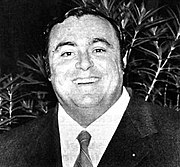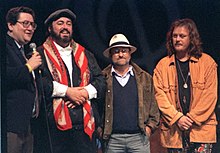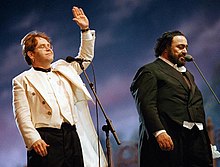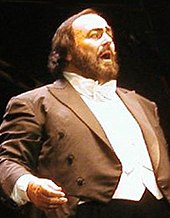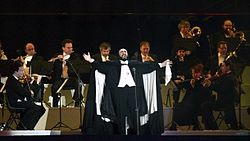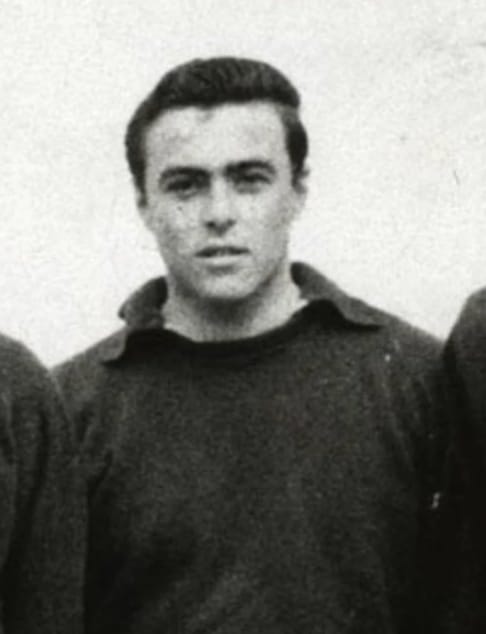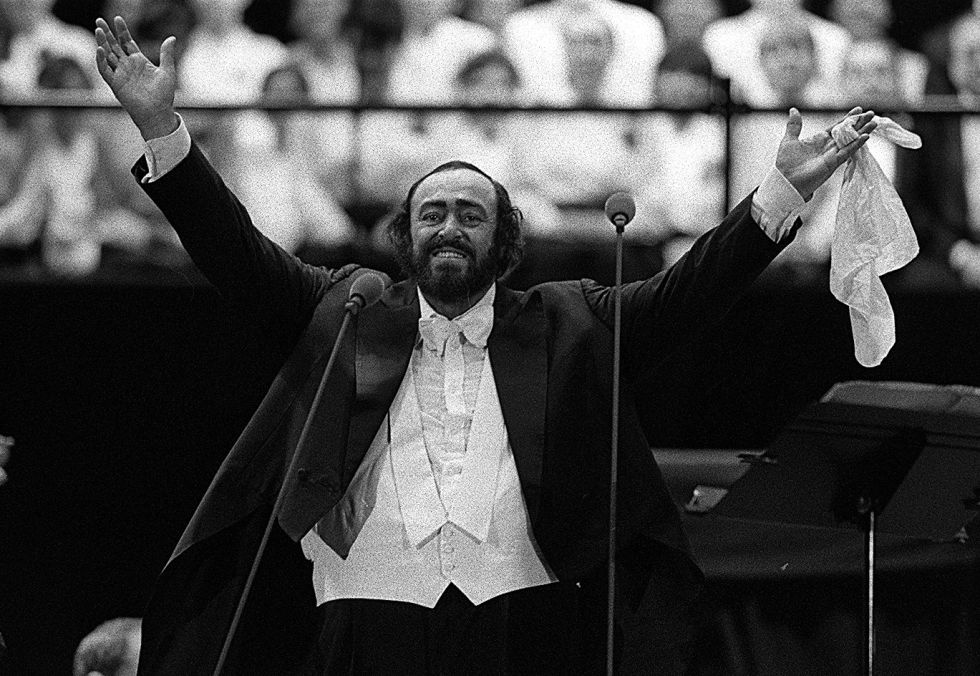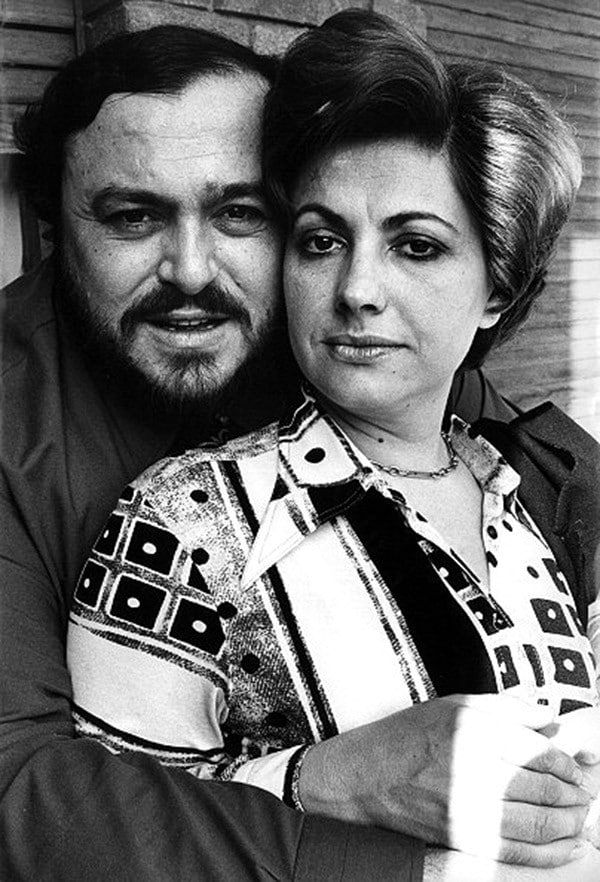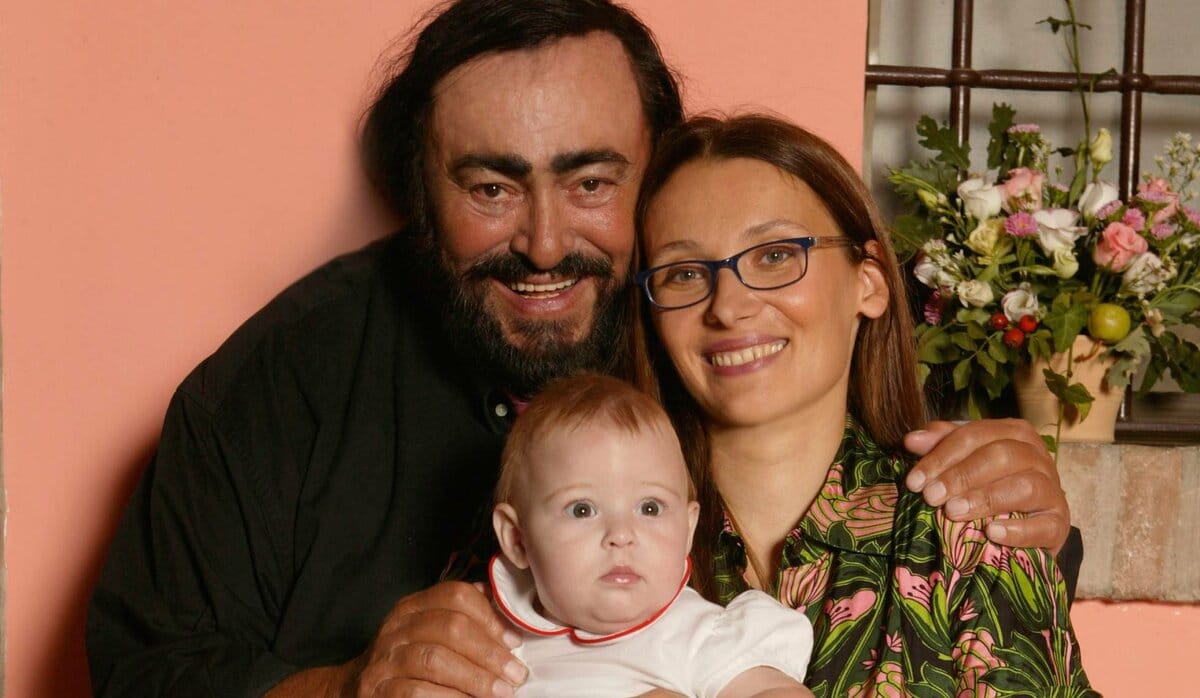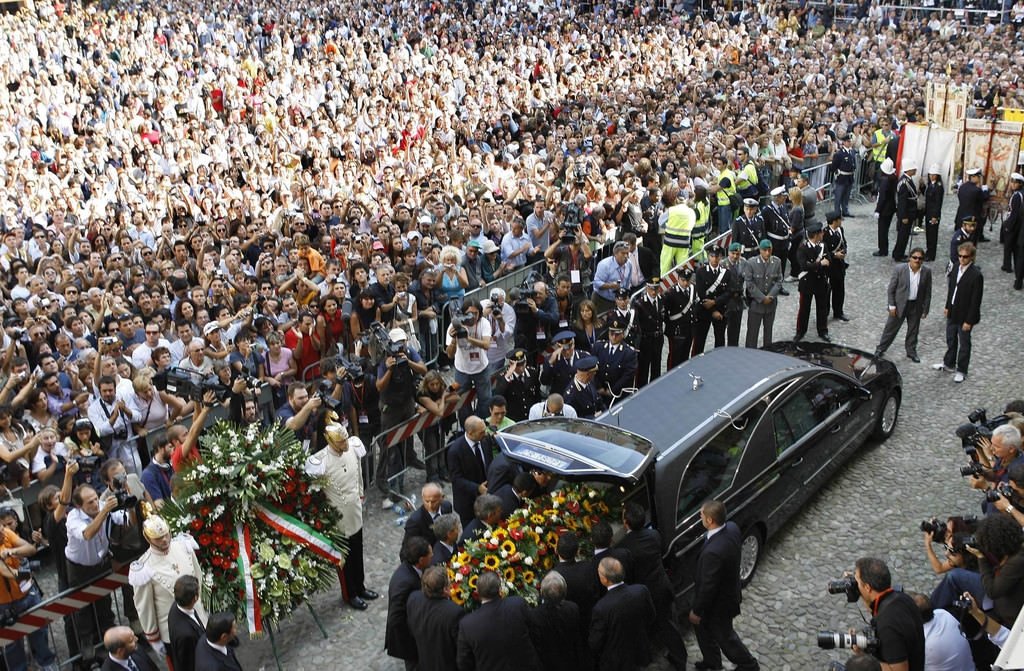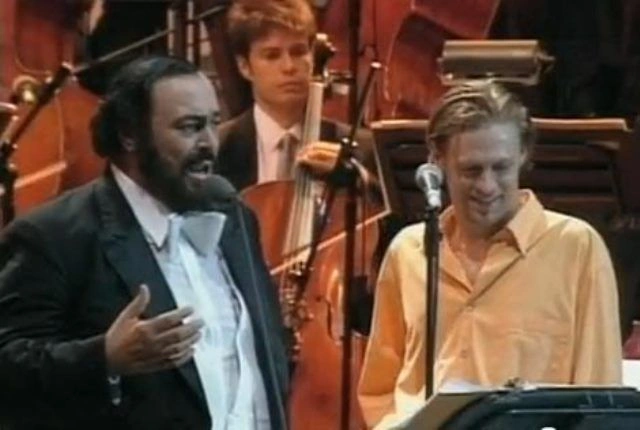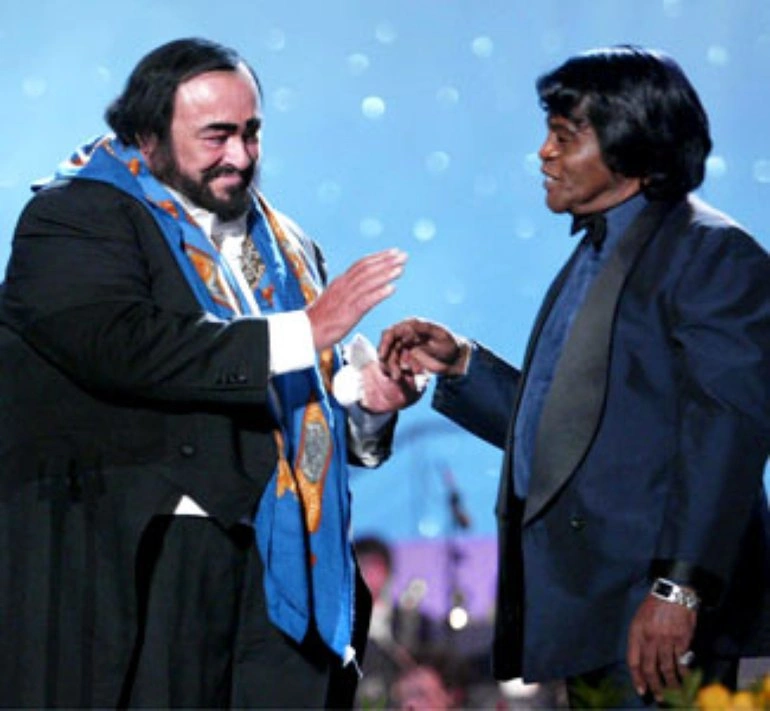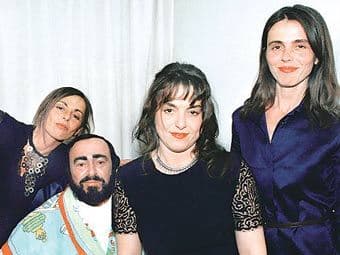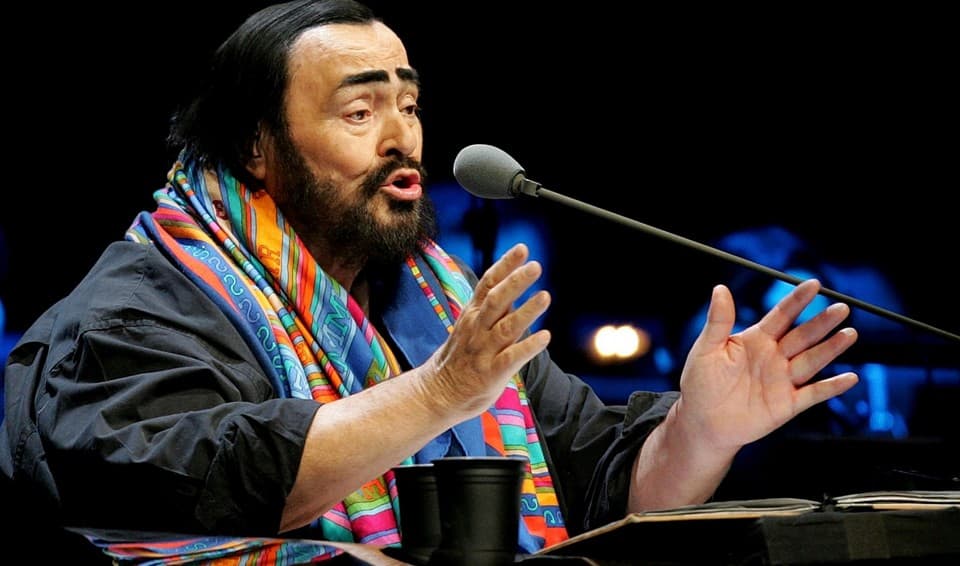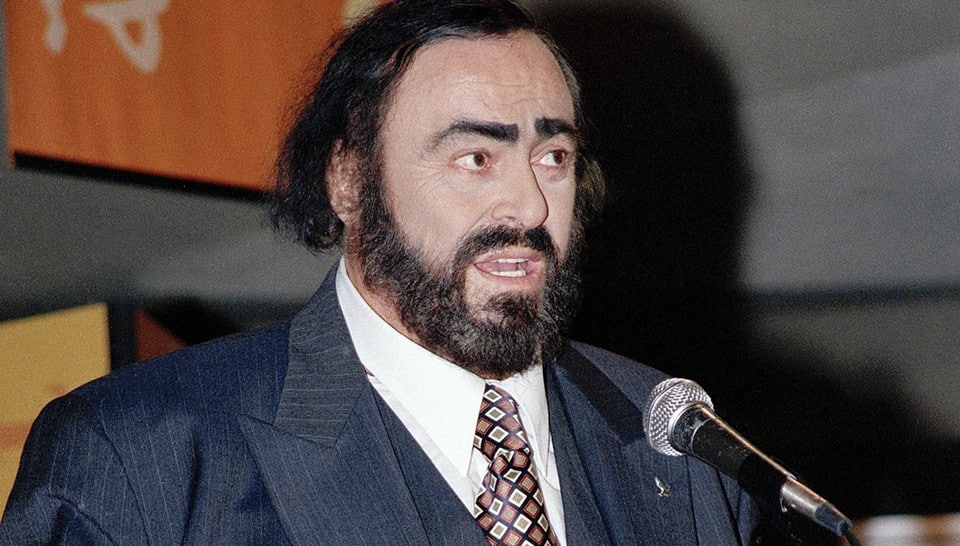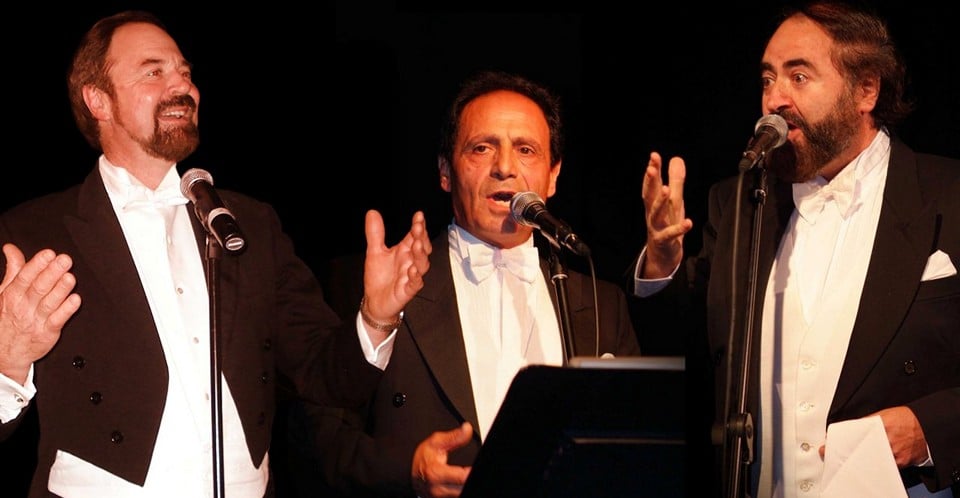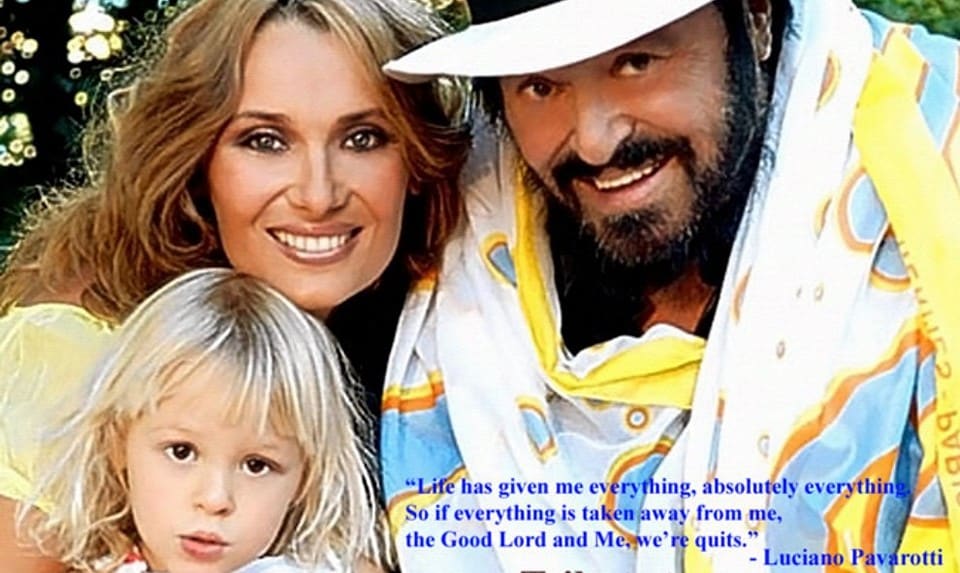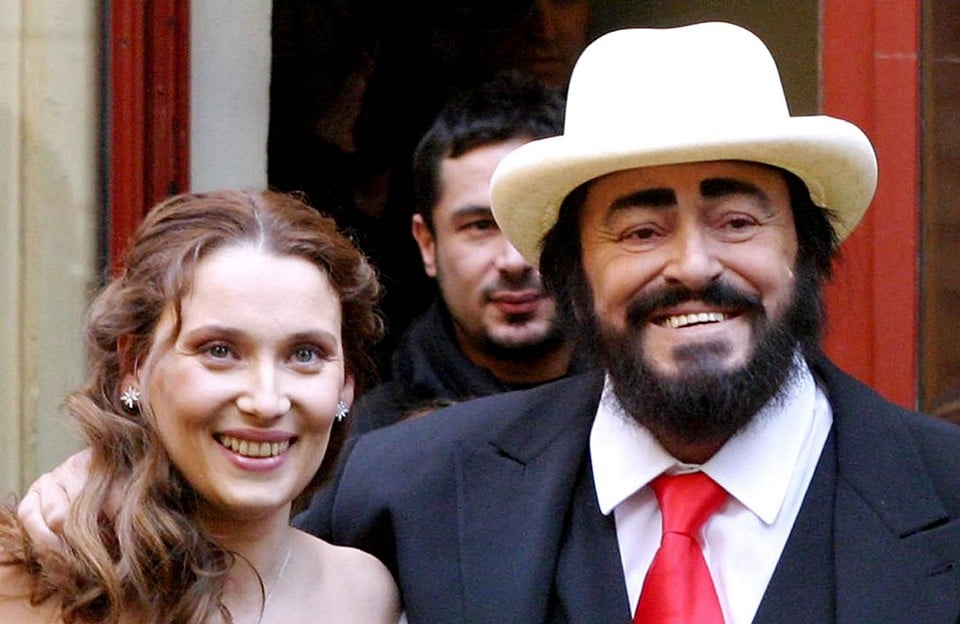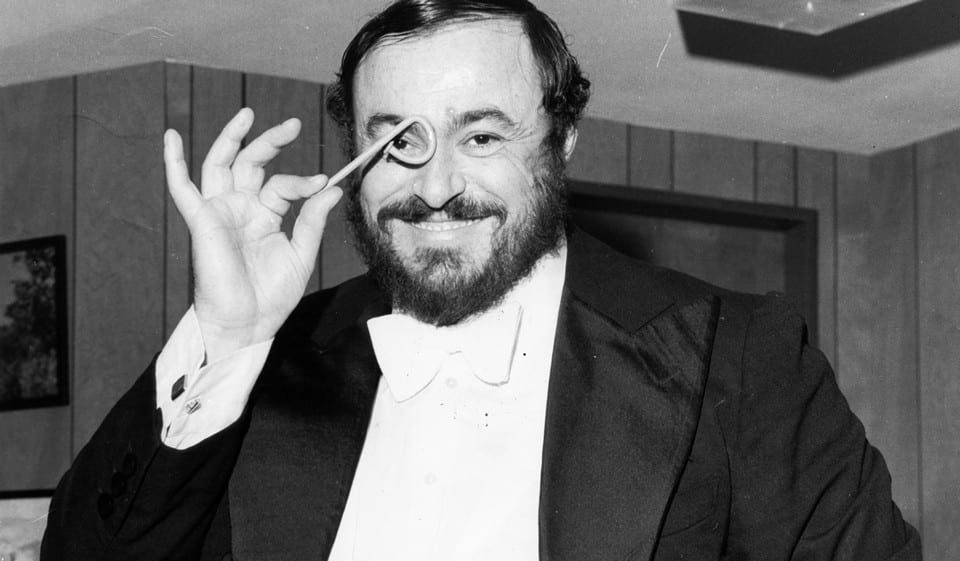| Лучано Паваротти Luciano Pavarotti |
|
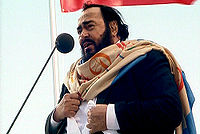 |
|
| Дата рождения |
12 октября 1935 |
|---|---|
| Место рождения |
Модена |
| Дата смерти |
6 сентября 2007 |
| Место смерти |
Модена |
| Страна |
|
| Профессия |
певец |
| Певческий голос |
тенор |
| http://www.lucianopavarotti.com |
Луча́но Паваро́тти (итал. Luciano Pavarotti; 12 октября 1935, Модена — 6 сентября 2007, Модена) — знаменитый итальянский певец (тенор) и один из наиболее известных исполнителей современности в мире оперы и в области других музыкальных жанров. Известный своими транслируемыми по телевидению концертами, появлениями в прессе и как один из «Трёх теноров», Паваротти был также отмечен наградами за благотворительную работу по сбору денежных средств для беженцев и Красного Креста.
Паваротти начал свою карьеру не очень значительными выступлениями, выступая в оперных театрах по всей Европе. Ситуация изменилась, когда Джоан Сазерленд пригласила его для совместных выступлений в мировом турне. К 1977 году Паваротти стал известным по всему миру, прославленный своей силой и легкостью верхнего регистра. Его «верхнее до» стало визитной карточкой в течение всей карьеры.
Лучано Паваротти вошел в поп-культуру после исполнения Nessun Dorma на церемонии открытия мирового кубка FIFA в 1990 году в Италии. Первый из концертов известных «Трёх теноров» прошёл накануне последнего матча турнира. В концерте Паваротти спел со своими друзьями-тенорами Пласидо Доминго и Хосе Каррерасом. В течение этих концертов Паваротти обратил произведения, ранее ограниченные оперным театром, к гораздо более широкой аудитории. В дальнейшем певец исполнял песни на концертах с известными поп-звездами. В отличие от других исполнителей, перешедших в течение поп-музыки, Паваротти постоянно поддерживал свой статус высочайшего мастера в мире оперы.
Содержание
- 1 Ранние годы
- 2 Карьера
- 2.1 1960—1980
- 3 Музыкальная деятельность
- 4 Ссылки
- 5 Примечания
Ранние годы
Лучано Паваротти родился на окраине города Модена на севере Италии, будучи сыном Фернандо Паваротти — пекаря и певца, и Адель Вентури — рабочей фабрики по производству сигар. Несмотря на то, что семья имела мало денег, певец всегда отзывался с любовью о своём детстве. Четверо членов семьи жили в двухкомнатном жилище. Как говорил певец, его отец имел красивый теноровый голос, но был неспособен к карьере певца из-за нервозности. Вторая мировая война вынудила семью уйти из города в 1943 году. В течение последующего года они снимали одну комнату на ферме в соседней деревне, где Паваротти заинтересовался фермерством.
Ранние музыкальные пристрастия Паваротти заключались в записях его отца, большинство из которых включали популярных теноров тех времен — Беньямино Джильи, Жованни Мартинелли, Тито Скипа и Энрико Карузо. Когда Лучано было около девяти лет, он начал петь со своим отцом в небольшом местном церковном хоре. Также в период молодости он провел несколько уроков с профессором Донди и его женой, однако не придавал им большого значения.
После того, что могло называться обычным детством с обычными интересами в спорте — в случае Паваротти это прежде всего был футбол — он окончил школу Schola Magistrale и столкнулся с дилеммой о выборе дальнейшей профессии. Паваротти был заинтересован в получении карьеры профессионального вратаря, но мать убедила его стать учителем. Впоследствии он преподавал в начальной школе два года, но в конце концов интерес к музыке взял верх. Осознавая весь риск, отец с неохотой дал согласие на то, что Лучано получит бесплатную комнату и еду до 30 лет, после которых, если ему не повезёт с карьерой певца, он будет зарабатывать сам себе на еду всеми способами, которыми сможет.
Паваротти начал серьёзное обучение в 1954 году в возрасте 19 лет с Арриго Пола — уважаемым учителем и профессиональным тенором в Модене, который будучи осведомлённым о бедности семьи, предложил давать уроки без оплаты. Только тогда Паваротти узнал, что у него абсолютный слух. Примерно в это время Паваротти познакомился с Адуа Верони, которая также была оперной певицей. Лучано и Адуа поженились в 1961 году. Когда через два с половиной года Пола уехал в Японию, Паваротти стал учеником Эттори Кампогаллиани, который также учил подругу детства Паваротти, теперь известную певицу, сопрано Миреллу Френи. В течение своего обучения Паваротти нанимался на работу на неполный рабочий день — сначала как учитель в начальной школе, а потом, когда он потерпел в этом неудачу, как страховой агент.
Первые шесть лет обучения не привели ни к чему большему, чем нескольким сольным концертам в маленьких городах без оплаты. Когда на голосовых связках образовалось утолщение (складка), что вызвало «ужасный» концерт в Ферраре, Паваротти решил завязать с пением. Однако впоследствии утолщение не только исчезло, но, как певец говорил в своей автобиографии, «всё, что я выучил, пришло вместе с моим натуральным голосом, чтобы сделать звук таким, какого я так тяжело добивался».
Карьера
1960—1980
Творческая карьера Паваротти началась в 1961 с победы на Международном конкурсе вокалистов. В том же году он дебютировал в Театре Реджио Эмилия, исполнив партию Родольфо в «Богеме» Дж. Пуччини. Эту же партию он исполнил в 1963 в Венской опере и лондонском Ковент-Гардене.
Дебют Паваротти в Америке состоялся в оперном театре Майами в феврале 1965 года, когда он спел в «Lucia di Lammermoor» Гаэтано Доницетти вместе в Сазерленд. Тенор, который должен был петь в тот вечер, заболел и не имел дублёра. Так как Сазерленд была с ним в туре, она рекомендовала молодого Паваротти, потому что он был хорошо знаком с ролью.
В последующие годы он пел в Ковент-Гардене партии Эльвино в «Сомнамбуле» Беллини, Альфредо в «Травиате» Верди, Герцога Мантуанского в вердиевском «Риголетто». Партия Тонио в опере «Дочери полка» Доницетти, спетая в 1966, принесла Паваротти международную известность: он стал первым в мире тенором, спевшим все девять высоких «до» в арии «Quel destin». После этого его стали называть «королем верхнего до». В том же году Паваротти дебютировал в миланском Ла Скала, где исполнил партию Тибальда в «Капулетти и Монтекки» Беллини. Со временем певец стал обращаться к драматическим ролям: Каварадосси в «Тоске» Пуччини, Риккардо в «Бале-маскараде», Манрико в «Трубадуре», Радамес в «Аиде» Верди.
С 1971 Паваротти регулярно выступал на фестивале «Арена ди Верона», участвовал в концертах, часто вместе с Пласидо Доминго и Хосе Каррерасом (концерты «трёх теноров»). Гастролировал с Ла Скала в Москве (1974). Среди записей партии в десяти операх Верди, пяти операх Пуччини; партии Канио (дирижёр Мути, Philips), Энцо в одной из наиболее удачных записей «Джоконды» Понкьелли (дирижёр Бартолетти, Philips) и другие.
Лучано Паваротти скончался в 5 утра 6 сентября 2007 года от рака поджелудочной железы в своём доме в Модене. Там же 8 сентября 2007 года прошли прощание и похороны маэстро. Похоронен на кладбище Монтале Рангоне (Montale Rangone) под Моденой, в семейном склепе, рядом с родителями и мертворожденным сыном.
Музыкальная деятельность
Лучано Паваротти был одним из самых популярных у публики и признаваемых критикой оперных теноров XX столетия.
На свои сольные концерты Паваротти собирал сотни тысяч слушателей. На одном из выступлений в нью-йоркском «Метрополитен Опера» зрители настолько были покорены красотой голоса певца, что занавес пришлось поднимать 165 раз[1]. Этот случай был занесен в Книгу рекордов Гиннесса. 500 тысяч зрителей слушали его концерт в Центральном парке Нью-Йорка — такую аудиторию не собирал ни один из популярных исполнителей[2]. С 1992 года Паваротти участвовал в благотворительных концертах «Паваротти и друзья». Благотворительный проект получил колоссальную известность благодаря участию рок-музыкантов Брайана Мэя и Рождера Тэйлора (Стинга, Боно и Эджа (Эрика Клептона, Джона Бон Джови, группы Cranberries, известных итальянских исполнителей, которые вместе с Паваротти и оркестром пели свои лучшие песни. Работать в этом проекте почитали за честь многие поп- и рок-музыканты. Альбомы, записанные проектом «Паваротти и друзья», стали сенсацией на рынке популярной музыки[3].
В певце всю его творческую биографию боролись серьезный классический вокалист и исполнитель песен легкого эстрадного жанра. И трудно сказать, что побеждало. Пожалуй, это больше интересовало слушателей и почитателей его таланта.
- Статья «ПАВАРОТТИ ПОКИДАЕТ ОПЕРНУЮ СЦЕНУ». По книге: Виктор Коршиков. Хотите, я научу вас любить оперу. О музыке и не только. Москва: Студия ЯТЬ, 2007:
По примеру своих молодых коллег Пласидо Доминго и Хосе Каррераса Паваротти занялся благотворительной деятельностью, дав ряд концертов под названием «Паваротти и друзья», где пел много популярных песенок вместе с эстрадными певцами, которые, в свою очередь, исполняли оперные арии. Многие любители критиковали Паваротти за подобные эксперименты, заставляющие воспринимать серьезную музыку как развлечение, и во многих крупных театрах ходило выражение: «Оперу загубили три человека и все три — теноры». К проекту «3 тенора» можно, конечно, относиться по-разному, но не стоит забывать, что это была благотворительная акция, посвященная выздоровлению Хосе Каррераса, и именно благодаря «трем тенорам» Паваротти и Доминго — давние враги помирились и стали выступать вместе в серьезных «настоящих» спектаклях, таких, как «Плащ» Пуччини и «Паяцы» Леонкавалло в «Метрополитен Опера» в один вечер. Лучано Паваротти — легенда. Он произвел оперную революцию, и даже его самые непримиримые критики не будут спорить, что его имя навсегда останется синонимом красоты человеческого голоса. («Русский Базар», № 16 (312), 2002 г.)
Ссылки
- Официальный сайт Lucianopavarotti
- Лучано Паваротти: про семью, карьеру и прощание с великим тенором.
Примечания
- ↑ The New York Times, September 7, 2007
- ↑ ‘The World Says Rest in Peace to Luciano Pavarotti’ — InfoNIAC, September 07 2007
- ↑ Биография. Лучано Паваротти
Wikimedia Foundation.
2010.
«Pavarotti» redirects here. For the documentary, see Pavarotti (film).
|
Luciano Pavarotti OMRI |
|
|---|---|

Pavarotti upon receiving the Kennedy Center Honors, 2001 |
|
| Born | 12 October 1935
Modena, Kingdom of Italy |
| Died | 6 September 2007 (aged 71)
Modena, Italy |
| Occupation | Opera singer (tenor) |
| Years active | 1955–2006 |
| Spouses |
|
| Children | 4 |
| Signature | |
Luciano Pavarotti Cavaliere di Gran Croce OMRI (, , Italian: [luˈtʃaːno pavaˈrɔtti]; 12 October 1935 – 6 September 2007) was an Italian operatic tenor who during the late part of his career crossed over into popular music, eventually becoming one of the most acclaimed tenors of all time. He made numerous recordings of complete operas and individual arias, gaining worldwide fame for his tone, and gaining the nickname «King of the High Cs».
As one of the Three Tenors, who performed their first concert during the 1990 FIFA World Cup before a global audience, Pavarotti became well known for his televised concerts and media appearances. From the beginning of his professional career as a tenor in 1961 in Italy to his final performance of «Nessun dorma» at the 2006 Winter Olympics in Turin, Pavarotti was at his best in bel canto operas, pre-Aida Verdi roles, and Puccini works such as La bohème, Tosca, Turandot and Madama Butterfly. He sold over 100 million records, and the first Three Tenors recording became the best-selling classical album of all time. Pavarotti was also noted for his charity work on behalf of refugees and the Red Cross, amongst others. He died from pancreatic cancer on 6 September 2007.
Biography
Early life and musical training
Luciano Pavarotti was born in 1935 on the outskirts of Modena in Northern Italy, the son of Fernando Pavarotti, a baker and amateur tenor, and Adele Venturi, a cigar factory worker.[1] Although he spoke fondly of his childhood, the family had little money; its four members were crowded into a two-room apartment. According to Pavarotti, his father had a fine tenor voice but rejected the possibility of a singing career because of nervousness. World War II forced the family out of the city in 1943. For the following year they rented a single room from a farmer in the neighbouring countryside, where the young Pavarotti developed an interest in farming.
After abandoning the dream of becoming a football goalkeeper, Pavarotti spent seven years in vocal training. Pavarotti’s earliest musical influences were his father’s records, most of them featuring the popular tenors of the day—Beniamino Gigli, Giovanni Martinelli, Tito Schipa, and Enrico Caruso. Pavarotti’s favourite tenor and idol was Giuseppe Di Stefano and he was also deeply influenced by Mario Lanza, saying: «In my teens I used to go to Mario Lanza movies and then come home and imitate him in the mirror». At around the age of nine he began singing with his father in a small local church choir.
In addition to music, as a child Pavarotti enjoyed playing football. When he graduated from the Scuola Magistrale he was interested in pursuing a career as a professional football goalkeeper, but his mother convinced him to train as a teacher. He subsequently taught in an elementary school for two years but finally decided to pursue a music career. His father, recognising the risk involved, only reluctantly gave his consent. Pavarotti began the serious study of music in 1954 at the age of 19 with Arrigo Pola, a respected teacher and professional tenor in Modena who offered to teach him without remuneration. According to conductor Richard Bonynge, Pavarotti never learned to read music.[2]
In 1955, he experienced his first singing success when he was a member of the Corale Rossini, a male voice choir from Modena that also included his father, which won first prize at the International Eisteddfod in Llangollen, Wales. He later said that this was the most important experience of his life, and that it inspired him to become a professional singer.[3] At about this time Pavarotti first met Adua Veroni. They married in 1961. When his teacher Arrigo Pola moved to Japan, Pavarotti became a student of Ettore Campogalliani, who at that time was also teaching Pavarotti’s childhood friend, Mirella Freni, whose mother worked with Luciano’s mother in the cigar factory. Like Pavarotti, Freni went on to become a successful opera singer; they would go on to collaborate in various stage performances and recordings together.
During his years of musical study, Pavarotti held part-time jobs in order to sustain himself—first as an elementary school teacher and then as an insurance salesman. The first six years of study resulted in only a few recitals, all in small towns and without pay. When a nodule developed on his vocal cords, causing a «disastrous» concert in Ferrara, he decided to give up singing. Pavarotti attributed his immediate improvement to the psychological release connected with this decision. Whatever the reason, the nodule not only disappeared but, as he related in his autobiography: «Everything I had learned came together with my natural voice to make the sound I had been struggling so hard to achieve».
Career: 1960s–1970s
Pavarotti began his career as a tenor in smaller regional Italian opera houses, making his debut as Rodolfo in La bohème at the Teatro Municipale in Reggio Emilia in April 1961. His first known recording of «Che gelida manina» was recorded during this performance.[4] Pavarotti’s first of two marriages was to his first wife Adua Veroni which lasted from 1961 to 2000 and they had three daughters: Lorenza, Cristina, and Giuliana.[5]
Luciano Pavarotti in 1972
He made his first international appearance in La traviata in Belgrade, Yugoslavia. Very early in his career, on 23 February 1963, he debuted at the Vienna State Opera in the same role. In March and April 1963 Vienna saw Pavarotti again as Rodolfo and as Duca di Mantova in Rigoletto. The same year saw his first concert outside Italy when he sang in Dundalk, Ireland for the St Cecilia’s Gramophone Society, he was engaged by the Dublin Grand Opera Society to sing The Duke of Mantua in Verdi’s Rigoletto in May and June, and his Royal Opera House debut, where he replaced an indisposed Giuseppe Di Stefano as Rodolfo.[6][7][8]
There exist on archive.org three complete performances from Pavarotti’s early career in 1964, when he was engaged by the Dublin Grand Opera Society to sing Rudolfo in Giacomo Puccini’s La bohème [9] (Audio recording of LA BOHEME Presented on May 19, 21, 27, Jun 1 1964 at the Gaiety Theatre Dublin as part of the Dublin Grand Opera Society’s Spring Season) and Alfredo in Giuseppe Verdi’s La Traviata [10] (Audio recording of LA TRAVIATA Presented on Jun 8 1964 at the Gaiety Theatre Dublin as part of the Dublin Grand Opera Society’s Spring Season, Audio recording of LA TRAVIATA Presented on May 25, 1964 at the Gaiety Theatre Dublin as part of the Dublin Grand Opera Society’s Spring Season). Also available are reviews of those performances in which the reviewers favorably comment on his singing (from the reviews for «La Boheme»): «sang sweetly and appealingly,» «rich promise,» «outstanding,» «fit for the big heroic roles,» and «robust;» his voice: «pure tone», «arresting quality,» «unforced strength and range,» «well sustained,» and «lovely;» and his acting: «looked and moved well,» «sang with musically-directed intelligence,» «used the voice to reinforce his acting,» and «chief delight of the evening.»[11]
While generally successful, Pavarotti’s early roles did not immediately propel him into the stardom that he would later enjoy. An early coup involved his connection with Joan Sutherland (and her conductor husband, Richard Bonynge), who in 1963 was seeking a tenor taller than herself to take along on her 1965 tour to Australia.[12] With his commanding physical presence, Pavarotti proved ideal.[13] However, before the summer 1965 Australia tour Pavarotti sang with Joan Sutherland when he made his American début with the Greater Miami Opera in February 1965, singing in Donizetti’s Lucia di Lammermoor on the stage of the Miami-Dade County Auditorium in Miami. The tenor scheduled to perform that night became ill with no understudy. As Sutherland had plans to travel with him on the Australia tour that summer, she recommended the young Pavarotti as he was acquainted with the role. Shortly after, on 28 April, Pavarotti made his La Scala debut in the revival of the Franco Zeffirelli production of La bohème, with his childhood friend Mirella Freni singing Mimi and Herbert von Karajan conducting. Karajan had requested the singer’s engagement.
During the Australia tour in summer 1965 Sutherland and Pavarotti sang some forty performances over two months, and Pavarotti later credited Sutherland for the breathing technique that would sustain him over his career.[14] After the extended Australian tour, he returned to La Scala, where he added Tebaldo from I Capuleti e i Montecchi to his repertoire on 26 March 1966, with Giacomo Aragall as Romeo. His first appearance as Tonio in Donizetti’s La fille du régiment took place at the Royal Opera House, Covent Garden, on 2 June of that year. It was his performances of this role that would earn him the title of «King of the High Cs».[15][16] He scored another major triumph in Rome on 20 November 1969 when he sang in I Lombardi opposite Renata Scotto. This was recorded on a private label and widely distributed, as were various recordings of his I Capuleti e i Montecchi, usually with Aragall. Early commercial recordings included a recital of Donizetti (the aria from Don Sebastiano were particularly highly regarded) and Verdi arias, as well as a complete L’elisir d’amore with Sutherland.
His major breakthrough in the United States came on 17 February 1972, in a production of La fille du régiment at New York’s Metropolitan Opera, in which he drove the crowd into a frenzy with his nine effortless high Cs in the signature aria. He achieved a record seventeen curtain calls. Pavarotti sang his international recital début at William Jewell College in Liberty, Missouri, on 1 February 1973, as part of the college’s Fine Arts Program, now known as the Harriman–Jewell Series. Perspiring due to nerves and a lingering cold, the tenor clutched a handkerchief throughout the début. The prop became a signature part of his solo performances. He began to give frequent television performances, starting with his performances as Rodolfo (La bohème) in the first Live from the Met telecast in March 1977, which attracted one of the largest audiences ever for a televised opera. He won many Grammy awards and platinum and gold discs for his performances. In addition to the previously listed titles, his La favorite with Fiorenza Cossotto and his I puritani (1975) with Sutherland stand out.
In 1976, Pavarotti debuted at the Salzburg Festival, appearing in a solo recital on 31 July, accompanied by pianist Leone Magiera. Pavarotti returned to the festival in 1978 with a recital and as the Italian singer in Der Rosenkavalier in 1983 with Idomeneo, and both in 1985 and 1988 with solo recitals. In 1979, he was profiled in a cover story in the weekly magazine Time.[17] That same year saw Pavarotti’s return to the Vienna State Opera after an absence of fourteen years. With Herbert von Karajan conducting, Pavarotti sang Manrico in Il trovatore. In 1978, he appeared in a solo recital on Live from Lincoln Center.
Career: 1980s–1990s
At the beginning of the 1980s, he set up The Pavarotti International Voice Competition for young singers, performing with the winners in 1982 in excerpts of La bohème and L’elisir d’amore. The second competition, in 1986, staged excerpts of La bohème and Un ballo in maschera. To celebrate the 25th anniversary of his career, he brought the winners of the competition to Italy for gala performances of La bohème in Modena and Genoa, and then to China where they staged performances of La bohème in Beijing (Peking). To conclude the visit, Pavarotti performed the inaugural concert in the Great Hall of the People before 10,000 people, receiving a standing ovation for nine effortless high Cs. The third competition in 1989 again staged performances of L’elisir d’amore and Un ballo in maschera. The winners of the fifth competition accompanied Pavarotti in performances in Philadelphia in 1997.
In the mid-1980s, Pavarotti returned to two opera houses that had provided him with important breakthroughs, the Vienna State Opera and La Scala. Vienna saw Pavarotti as Rodolfo in La bohème with Carlos Kleiber conducting and again Mirella Freni was Mimi; as Nemorino in L’elisir d’amore; as Radames in Aida conducted by Lorin Maazel; as Rodolfo in Luisa Miller; and as Gustavo in Un ballo in maschera conducted by Claudio Abbado. In 1996, Pavarotti appeared for the last time at the Staatsoper in Andrea Chénier. Throughout the 1980s and 90s, promoters Tibor Rudas and Harvey Goldsmith booked Pavarotti into increasingly larger venues.
In 1985, Pavarotti sang Radames at La Scala opposite Maria Chiara in a Luca Ronconi production conducted by Maazel, recorded on video. His performance of the aria «Celeste Aida» received a two-minute ovation on the opening night. He was reunited with Mirella Freni for the San Francisco Opera production of La bohème in 1988, also recorded on video. In 1992, La Scala saw Pavarotti in a new Zeffirelli production of Don Carlos, conducted by Riccardo Muti. Pavarotti’s performance was heavily criticised by some observers and booed by parts of the audience.
Pavarotti became even better known throughout the world in 1990 when his rendition of the aria «Nessun dorma» from Giacomo Puccini’s Turandot was taken as the theme song of BBC’s coverage of the 1990 FIFA World Cup in Italy. The aria achieved pop status, became the World Cup soundtrack, and it remained his trademark song.[18] This was followed by the first Three Tenors concert, held on the eve of the 1990 FIFA World Cup Final at the ancient Baths of Caracalla in Rome with fellow tenors Plácido Domingo and José Carreras and conductor Zubin Mehta. The performance for the World Cup closing concert captivated a global audience, and it became the biggest selling classical record of all time.[19] A highlight of the concert, in which Pavarotti sang the opening verses using extended vocal runs for di Capua’s «O Sole Mio» and which was in turn perfectly repeated note-for-note by Domingo and Carreras to the delight of the audience. The recorded album sold millions of copies,[20] and the first Three Tenors recording became the best-selling classical album of all time.[21] Throughout the 1990s, Pavarotti appeared in many well-attended outdoor concerts, including his televised concert in London’s Hyde Park, which drew a record attendance of 150,000. In June 1993, more than 500,000 listeners gathered for his free performance on the Great Lawn of New York’s Central Park, while millions more around the world watched on television. The following September, in the shadow of the Eiffel Tower in Paris, he sang for an estimated crowd of 300,000. Following on from the original 1990 concert, the Three Tenors concerts were held during the three subsequent FIFA World Cup Finals, in 1994 in Los Angeles, 1998 in Paris, and 2002 in Yokohama.[22]
In September 1995, Pavarotti performed Schubert’s Ave Maria along with Dolores O’Riordan; Diana, Princess of Wales, who attended the live performance, told O’Riordan that the song brought her to tears.[23] In 1995, Pavarotti’s friends, the singer Lara Saint Paul (as Lara Cariaggi) and her husband showman Pier Quinto Cariaggi, who had produced and organised Pavarotti’s 1990 FIFA World Cup Celebration Concert at the PalaTrussardi in Milan,[24] produced and wrote the television documentary The Best is Yet to Come, an extensive biography about the life of Pavarotti.[25] Lara Saint Paul was the interviewer for the documentary with Pavarotti, who spoke candidly about his life and career.[25]
Pavarotti’s rise to stardom was not without occasional difficulties, however. He earned a reputation as «The King of Cancellations» by frequently backing out of performances, and his unreliable nature led to poor relationships with some opera houses. This was brought into focus in 1989 when Ardis Krainik of the Lyric Opera of Chicago severed the house’s 15-year relationship with the tenor.[26] Over an eight-year period, Pavarotti had cancelled 26 out of 41 scheduled appearances at the Lyric, and the decisive move by Krainik to ban him for life was well noted throughout the opera world, after the performer walked away from a season premiere less than two weeks before rehearsals began, saying pain from a sciatic nerve required two months of treatment. On 12 December 1998, he became the first (and, to date, only) opera singer to perform on Saturday Night Live, singing alongside Vanessa L. Williams. He also sang with U2 in the band’s 1995 song «Miss Sarajevo» and with Mercedes Sosa in a big concert at the Boca Juniors arena La Bombonera in Buenos Aires, Argentina, in 1999. In 1998, Pavarotti was presented with the Grammy Legend Award.
Career: Early 2000s
In 2001, Pavarotti was acquitted in Italian court of a long standing dispute concerning his official country of residency and taxable earnings.[27] Pavarotti long claimed Monte Carlo in the tax haven of Monaco as his official residence, but an Italian court in 1999 had rejected that claim by ruling that his Monaco address could not accommodate his entire family.[28] In 2000 Pavarotti agreed to pay the Italian government more than $7.6 million in back taxes and penalties as a result of tax evasion charges that dated from 1989 to 1995. Pavarotti was subsequently fully acquitted by an Italian court of filing false tax returns in 2001.[29]
Pavarotti and family, N.Y.C., 1979–1983. Clockwise from top: Luciano Pavarotti, daughters Cristina and Lorenza Pavarotti, wife Adua Veroni, daughter Giuliana Pavarotti.
On 13 December 2003, he married his second wife and former personal assistant, Nicoletta Mantovani (born 1969), with whom he already had another daughter, Alice. Alice’s twin brother, Riccardo, was stillborn after complications in January 2003. At the time of his death in September 2007, he was survived by his wife, his four daughters, and one granddaughter.[30][31][32]
In late 2003, he released his final compilation—and his first and only «crossover» album, Ti Adoro. Most of the 13 songs were written and produced by Michele Centonze, who had already helped produce the «Pavarotti & Friends» concerts between 1998 and 2000.[33] The tenor described the album as a wedding gift to Nicoletta Mantovani. That same year he was made a Commander of Monaco’s Order of Cultural Merit.[34]
In 2004, one of Pavarotti’s former managers, Herbert Breslin, published a book, The King & I.[26] Seen by critics as bitter and sensationalistic, it is critical of the singer’s acting (in opera), his inability to read music well and learn parts, and his personal conduct, although acknowledging their success together. In an interview in 2005 with Jeremy Paxman on the BBC, Pavarotti rejected the allegation that he could not read music, although he acknowledged he did not read orchestral scores.
He received an enormous number of awards and honours, including Kennedy Center Honors in 2001. He also holds two Guinness World Records: one for receiving the most curtain calls (165)[35] and another for the best-selling classical album (Carreras Domingo Pavarotti in Concert by the Three Tenors; the latter record is thus shared by fellow tenors Plácido Domingo and José Carreras).
Final performances and health issues
Pavarotti began his farewell tour in 2004, at the age of 69, performing one last time in old and new locations, after more than four decades on the stage. On 13 March 2004, Pavarotti gave his last performance in an opera at the New York Metropolitan Opera, for which he received a long standing ovation for his role as the painter Mario Cavaradossi in Giacomo Puccini’s Tosca. On 1 December 2004, he announced a 40-city farewell tour. Pavarotti and his manager, Terri Robson, commissioned impresario Harvey Goldsmith to produce the Worldwide Farewell Tour. His last full-scale performance was at the end of a two-month Australasian tour in Taiwan in December 2005.
In March 2005, Pavarotti underwent neck surgery to repair two vertebrae. In early 2006, he underwent further back surgery and contracted an infection while in the hospital in New York, forcing cancellation of concerts in the U.S., Canada, and the U.K.[36]
On 10 February 2006, Pavarotti performed «Nessun dorma» at the 2006 Winter Olympics opening ceremony in Turin, Italy, at his final performance.[37] In the last act of the opening ceremony, his performance received the longest and loudest ovation of the night from the international crowd. Leone Magiera, who directed the performance, revealed in his 2008 memoirs, Pavarotti Visto da Vicino, that the performance had been recorded weeks earlier.[38] «The orchestra pretended to play for the audience, I pretended to conduct and Luciano pretended to sing. The effect was wonderful,» he wrote. Pavarotti’s manager, Terri Robson, said that the tenor had turned the Winter Olympic Committee’s invitation down several times because it would have been impossible to sing late at night in the subzero conditions of Turin in February. The committee eventually persuaded him to take part by prerecording the song.
Death
While proceeding with an international «farewell tour», Pavarotti was diagnosed with pancreatic cancer in July 2006. The tenor fought back against the implications of this diagnosis, undergoing major abdominal surgery and making plans for the resumption and conclusion of his singing commitments,[39] but he died at his home in Modena on 6 September 2007. After his death, his manager, Terri Robson, noted in a statement, «The Maestro fought a long, tough battle against the pancreatic cancer which eventually took his life. In fitting with the approach that characterised his life and work, he remained positive until finally succumbing to the last stages of his illness».[40][41][42]
Pavarotti’s funeral was held at Modena Cathedral. The then Prime Minister Romano Prodi and Kofi Annan attended.[43] The Frecce Tricolori, the aerobatic demonstration team of the Italian Air Force, flew overhead, leaving green-white-red smoke trails. After a funeral procession through the centre of Modena, Pavarotti’s coffin was taken the final ten kilometres (6 miles) to Montale Rangone, a village part of Castelnuovo Rangone, and was interred in the Pavarotti family crypt. The funeral, in its entirety, was also telecast live on CNN. The Vienna State Opera and the Salzburg Festival Hall flew black flags in mourning.[44] Tributes were published by many opera houses, such as London’s Royal Opera House.[45]
Other work
Film and television
Pavarotti’s one venture into film was Yes, Giorgio (1982), a romantic comedy movie directed by Franklin J. Schaffner, in which he starred as the main character Giorgio Fini. The film was a critical and commercial failure, although it received an Academy Award nomination for Best Music, Original Song.
He can be seen to better advantage in Jean-Pierre Ponnelle’s movie Rigoletto, an adaptation of the opera of the same name also released in 1982, or in his more than 20 live opera performances taped for television between 1978 and 1994, most of them with the Metropolitan Opera, and most available on DVD.
He received two Primetime Emmy Awards for his PBS variety specials Pavarotti in Philadelphia: La Boheme and Duke of Mantua, Rigoletto Great Performances.[46]
Pavarotti, a 2019 documentary film about him, was directed by Ron Howard and produced with the cooperation of Pavarotti’s estate using family archives, interviews and live music footage.[47]
Humanitarianism
Pavarotti annually hosted the Pavarotti & Friends charity concerts in his home town of Modena Italy, joining with singers from all parts of the music industry, including B.B. King, Andrea Bocelli, Zucchero, Jon Bon Jovi, Bryan Adams, Bono, James Brown, Mariah Carey, Eric Clapton, Dolores O’Riordan, Sheryl Crow, Céline Dion, Anastacia, Elton John, Deep Purple, Meat Loaf, Queen, George Michael, Tracy Chapman, the Spice Girls, Sting and Barry White to raise money for several UN causes. Concerts were held for War Child, and victims of war and civil unrest in Bosnia, Guatemala, Kosovo and Iraq. After the war in Bosnia, he financed and established the Pavarotti Music Centre in the southern city of Mostar to offer Bosnia’s artists the opportunity to develop their skills. For these contributions, the city of Sarajevo named him an honorary citizen in 2006.[48]
He performed at benefit concerts to raise money for victims of tragedies such as the Spitak earthquake that killed 25,000 people in northern Armenia in December 1988,[49] and sang Gounod’s Ave Maria with legendary French pop music star and ethnic Armenian Charles Aznavour.
He was a close friend of Diana, Princess of Wales. They raised money for the elimination of land mines worldwide.[50]
In 1998, he was appointed the United Nations Messenger of Peace, using his fame to raise awareness of UN issues, including the Millennium Development Goals, HIV/AIDS, child rights, urban slums and poverty.[51]
In 1999, Pavarotti performed a charity benefit concert in Beirut, to mark Lebanon’s re-emergence on the world stage after a brutal 15-year civil war. The largest concert held in Beirut since the end of the war, it was attended by 20,000 people who travelled from countries as distant as Saudi Arabia and Bulgaria.[52] In 1999 he also hosted a charity benefit concert to build a school in Guatemala, for Guatemalan civil war orphans. It was named after him Centro Educativo Pavarotti. Now the foundation of nobel prize winner Rigoberta Menchú Tum is running the school.
In 2001, Pavarotti received the Nansen Medal from the UN High Commission for Refugees for his efforts raising money on behalf of refugees worldwide. Through benefit concerts and volunteer work, he has raised more than any other individual.[53]
Also in 2001, Pavarotti was chosen one of that year’s five recipients by the President and First Lady as an honoree for their lifetime achievements in the arts at the White House, followed by the Kennedy Center; the Kennedy Center Honors, He was surprised by the appearance of Secretary-General of the United Nations and that year’s winner of the Nobel Peace Prize, Kofi Annan, who lauded him for his contribution to humankind. Six months prior, Pavarotti had held a large charity concert for Afghan refugees, particularly children in his home town of Modena, Italy.[54][55]
Other honours he received include the «Freedom of London Award» and The Red Cross «Award for Services to Humanity», for his work in raising money for that organisation, and the 1998 «MusiCares Person of the Year», given to humanitarian heroes by the National Academy of Recording Arts and Sciences.[56]
He was a National Patron of Delta Omicron, an international professional music fraternity.[57]
Legacy and estate assignment
His first will was opened the day after his death; a second will was opened within the same month of September.[58] He left an estate outside his native Modena (now a museum), a villa in Pesaro, his flat in Monte Carlo, and three flats in New York City.[59]
Pavarotti’s widow’s lawyers, Giorgio Bernini and Anna Maria Bernini, and manager Terri Robson announced on 30 June 2008 that his family amicably settled his estate—€300 million ($474.2 million, including $15 million in U.S. assets). Pavarotti drafted two wills before his death: one divided his assets by Italian law, giving half to his second wife, Nicoletta Mantovani, and half to his four daughters; the second gave his U.S. holdings to Mantovani. The judge confirmed the compromise by the end of July 2008. However, a Pesaro public prosecutor, Massimo di Patria, investigated allegations that Pavarotti was not of sound mind when he signed the will.[60][61] Pavarotti’s estate has been settled «fairly», a lawyer for Mantovani said in statements after reports of a dispute between her and his three daughters from his first marriage.[62]
He posthumously received the Italy-USA Foundation’s America Award in 2013 and the Brit Award for Outstanding Contribution to Music in 2014.
Selected discography
In addition to his very large discography[63] of opera performances[64] Pavarotti also made many classical crossover and pop recordings, the Pavarotti & Friends series of concerts and, for Decca, a series of studio recital albums: first six albums of opera arias and then, from 1979, six albums of Italian song.
Studio recital albums
- Favourite Italian Arias – Arias from La Bohème, Tosca and Rigoletto. Orchestra of the Royal Opera House, Covent Garden Edward Downes Decca Records 1966
- Arias by Verdi & Donizetti – Arias from Luisa Miller, I due Foscari, Un ballo in maschera, Macbeth, Lucia di Lammermoor, Il duca d’Alba, La favorita and Don Sebastiano (with the Wiener Opernorchester under Edward Downes, 1968).[65]
- Tenor Arias from Italian Opera – Arias from Guglielmo Tell, I puritani, Il trovatore, L’arlesiana, La bohème, Mefistofele, Don Pasquale, La Gioconda and Giuseppe Pietri’s it:Maristella. Luciano Pavarotti tenor with Arleen Auger soprano. Leone Magiera (piano) Wiener Opernorchester and choir. Ambrosian Singers New Philharmonia Orchestra Nicola Rescigno 1971
- The World’s Favourite Tenor Arias’ – Tosca, Carmen, Aida, Faust, Pagliacci, Martha. Royal Philharmonic Orchestra. Wiener Volksoper Orchester. Leone Magiera. New Philharmonia Orchestra Richard Bonynge 1973
- Pavarotti in Concert – Arias and songs by Bononcini, Handel, Alessandro Scarlatti, Bellini, Tosti, Respighi, Rossini. Orchestra del Teatro Comunale di Bologna. Richard Bonynge. 1973
- O Holy Night – Songs and carols by Adam, Stradella, Franck, Mercadante, Schubert, Bach (arranged Gounod), Bizet, Berlioz, Pietro Yon, Alois Melichar. Wandsworth School Boys’ Choir. London Voices. National Philharmonic Orchestra, Kurt Herbert Adler 1976
- O Sole Mio – Favourite Neapolitan Songs 13 songs by Eduardo di Capua: O sole mio Francesco Paolo Tosti: ‘A vucchella, Enrico Cannio: O surdato ‘nnammurato, it:Salvatore Gambardella: O marenariello, Traditional: Fenesta vascia, Tosti: A Marechiare, Ernesto de Curtis: Torna a Surriento, Gaetano Errico Pennino: Pecchè?, Vincenzo d’Annibale: ‘O paese d’ ‘o sole, Ernesto Tagliaferri: Piscatore ‘e Pusilleco, Curtis: it:Tu ca nun chiagne, Capua: Maria, Mari, Luigi Denza: Funiculì funiculà. Orchestra del Teatro Comunale di Bologna Anton Guadagno National Philharmonic Orchestra it:Giancarlo Chiaramello 1979
- Verismo – Arias from Fedora, Mefistofele, Adriana Lecouvreur, Iris, L’Africaine, Werther, La fanciulla del West, Manon Lescaut, Andrea Chénier. National Philharmonic Orchestra Oliviero de Fabritiis (Riccardo Chailly for Andrea Chénier arias) 1979
- Mattinata – 14 songs by Caldara, formerly attrib. Pergolesi, probably by Vincenzo Ciampi: Tre giorni son che Nina, Bellini, Tommaso Giordani, Rossini, Gluck, Tosti, Donizetti, Leoncavallo, Beethoven and Francesco Durante. Philharmonia Orchestra Piero Gamba National Philharmonic Orchestra. Antonio Tonini (conductor) 1983
- Mamma – songs by Cesare Andrea Bixio, Ernesto de Curtis, Arturo Buzzi-Peccia, Stanislao Gastaldon, Cesare Cesarini, A. Walter Kramer, Carlo Innocenzi, Giovanni D’Anzi, Eldo di Lazzaro, Vincenzo De Crescenzo, Domenico Martuzzi, Aniello Califano, Colombino Arona. Arranged and conducted by Henry Mancini, 1984.
- Passione – 12 songs by Ernesto Tagliaferri, Paolo Tosti, :it:Pasquale Mario Costa, Teodoro Cottrau, it:Evemero Nardella, Rodolfo Falvo, De Curtis, Di Capua, E. A. Mario, Gaetano Lama and Salvatore Cardillo. Orchestra del Teatro Comunale di Bologna. Giancarlo Chiaramello 1985
- Volare – 16 songs by Domenico Modugno, Luigi Denza, Cesare Andrea Bixio, Gabriele Sibella, Giovanni D’Anzi, Michael John Bonagura, Edoardo Mascheroni, Ernesto De Curtis, Ermenegildo Ruccione, Pietro Mascagni, Guido Maria Ferilli. arranged and conducted by Henry Mancini 1987
- Ti Adoro – songs by Romano Musumarra, Carlo Mioli, Ornella D’Urbano, Michele Centonze, Andrea Bellantani, Daniel Vuletic, Veris Giannetti, Nino Rota/Elsa Morante, Edoardo Bennato, Hans Zimmer/Gavin Greenaway/Jeffrey Pescetto, Lucio Dalla. Royal Philharmonic Orchestra Orchestra di Roma. Bulgarian Symphony Orchestra. Romano Musumarra Giancarlo Chiaramello, 2000
Selected videography
- Mozart: Idomeneo (1982), Deutsche Grammophon DVD, 00440-073-4234, 2006
- The Metropolitan Opera Centennial Gala (1983), Deutsche Grammophon DVD, 00440-073-4538, 2009
- The Metropolitan Opera Gala 1991, Deutsche Grammophon DVD, 00440-073-4582, 2010
Awards and honors
Grammy Awards
The Grammy Awards are awarded annually by the National Academy of Recording Arts and Sciences.
Kennedy Center honors
See also
- List of best-selling music artists
- Pavarotti & Friends for the Children of Bosnia
- Pavarotti & Friends for the Children of Liberia
- Pavarotti & Friends for Guatemala and Kosovo
- Centro Educativo Pavarotti
- Pavarotti, a 2019 documentary film by Ron Howard
References
- ^ «Luciano Pavarotti Biography (1935–)». Film reference.com. Retrieved 2 January 2017.
- ^ «Richard Bonynge Talking Pavarotti» Interview on YouTube
- ^ «Pavarotti eisteddfod career start». BBC Online. 6 September 2007. Retrieved 7 September 2007.
- ^ Kennicott, Philip (13 March 2015). «Luciano Pavarotti – the birth of a legend». Gramophone.
- ^ Holland, Bernard (6 September 2007). «Luciano Pavarotti Is Dead at 71 (Published 2007)». The New York Times. ISSN 0362-4331. Retrieved 31 December 2020.
- ^ Paul Arendt, «It Was All About the Voice», The Guardian(London), 7 September 2007
- ^ Cunningham, Jimmy (13 September 2007). «I paid a fiver for a tenor.». Daily Mirror. Retrieved 29 January 2013
- ^ «1963 Concert Program, Dublin Grand Opera Society»
- ^ iarchive:1964s-la-boheme-dgos/page/9/mode/2up
- ^ [[iarchive:1964s-la-traviata-dgos|]]
- ^ «1964 / LA BOHEME / Puccini». 16 September 2020.
- ^ Joan Sutherland quoted in Paul Arendt, «It Was All About the Voice,» The Guardian, (London), 7 September 2007: «The young Pavarotti was a revelation to the opera world. He made his debut in the United States with us in Miami in 1965. He then came as part of our company to Australia, where he sang three times a week for 14 weeks, and we went on to make countless recordings together».
- ^ Richard Dyer, «Opera star Luciano Pavarotti dies: Epic career spanned 40 years», The Boston Globe, 6 September 2007
- ^ Ariel David, «World Mourns Italian Tenor Pavarotti» Archived 26 September 2007 at the Wayback Machine, WTOPnews.com, 6 September 2007
- ^ «Obituary: Luciano Pavarotti». The Times. London. 6 September 2007. Archived from the original on 25 July 2008.
- ^ Warrack, John and Ewan West (1996). «Luciano Pavarotti», The Concise Oxford Dictionary of Opera (3rd edition): Describes Pavarotti as having «… an excellent technique, and a conquering personality.»
- ^ «Time Magazine Cover: Luciano Pavarotti». Time–Life. 24 September 1979. Retrieved 2 January 2017.
- ^ «A riot of colour, emotion and memories: the World Cup stands alone in the field of sport». The Independent. Retrieved 20 August 2018.
- ^ «Pavarotti, top tenors sing for World Cup crowds». Upi. Retrieved 24 August 2018.
- ^ «In carriera ha venduto 100 milioni di dischi – Il mito Pavarotti». Il Quotidiano (in Italian). 6 September 2007.
- ^ Gareth Malone (2011). Music for the People: The Pleasures and Pitfalls of Classical Music. HarperCollins Publishers. pp. 34–. ISBN 978-0-00-739618-4. Retrieved 30 July 2013.
- ^ The Music Industry Handbook. Routledge. 2016. p. 219.
- ^ J-P, Mauro (15 January 2018). «When the Cranberries’ Dolores O’Riordan sang ‘Ave Maria’ with Pavarotti». Aleteia. Retrieved 18 January 2018.
- ^ Pavarotti, Luciano: The Event, The World Cup Celebration Concert (1990) Archived 24 January 2009 at the Wayback Machine
- ^ a b Pavarotti: The Best is Yet to Come, Penrith City Library Catalogue
- ^ a b Herbert H. Breslin, The King and I: The Uncensored Tale of Luciano Pavarotti’s Rise to Fame by His Manager, Friend and Sometime Adversary, New York: Doubleday Publishing, 2004 ISBN 978-0-385-50972-5 ISBN 0-385-50972-3
- ^ «Pavarotti wins tax case.», The Times, London, 20 October 2001.
- ^ «Pavarotti tax bill.», The Times, London, 27 April 1999.
- ^ «Pavarotti wins tax case.», The Times, London, 20 October 2001.
- ^ Holland, Bernard (6 September 2007). «Luciano Pavarotti Is Dead at 71 (Published 2007)». The New York Times. ISSN 0362-4331. Retrieved 31 December 2020.
- ^ Lehmann, John (14 May 2002). «PAVAROTTI DAUGHTER’S BABY GRAND». New York Post. Retrieved 31 December 2020.
- ^ «Is This Pavarotti’s Granddaughter Singing ‘Nessun Dorma’?». Snopes.com. 30 April 2020. Retrieved 31 December 2020.
- ^ «Amazon.com: The Pavarotti & Friends Collection: The Complete Concerts, 1992–2000: Luciano Pavarotti: Movies & TV». Amazon. 12 November 2002. Retrieved 2 January 2017.
- ^ Sovereign Ordonnance n° 16.053 of 18 Nov. 2003 : promotions or nominations in the Order of Cultural Merit
- ^ Block, Mervin (15 October 2004). «’60 Minutes’ Story About Singer Hits False Note». Poynter Online. Retrieved 10 October 2019.
- ^ «Pavarotti ‘will return to stage’«. BBC News. 25 July 2006. Retrieved 5 September 2007.
- ^ Kington, Tom (7 April 2008). «Pavarotti mimed at final performance». The Guardian. London. Retrieved 7 April 2008.
- ^ Kington, Tom (7 April 2008). «Pavarotti mimed at final performance». The Guardian. London. Retrieved 28 August 2009.
- ^ «Singer Luciano Pavarotti recovering from pancreatic cancer surgery». Fox News. 7 July 2006. Archived from the original on 9 July 2007. Retrieved 5 September 2007.
- ^ «Tenor Luciano Pavarotti dead at 71» on cnn.com, 6 September 2007 Archived 17 September 2007 at the Wayback Machine; retrieved on 6 September 2007
- ^ Pavarotti dead at 71: manager; retrieved on 6 September 2007
- ^ «Pavarotti Dead at Age 71». CBS News. 5 September 2007.
- ^ «Thousands bid Pavarotti farewell». BBC News – Entertainment. 8 September 2007. Retrieved 2 January 2017.
- ^ «Black flag flies over Vienna Opera House for Pavarotti». Agence France-Presse. 6 September 2007. Retrieved 6 September 2007.
- ^ Castonguay, Gilles (6 September 2007). «Luciano Pavarotti dead at 71». Reuters. Archived from the original on 11 October 2007. Retrieved 6 September 2007.
- ^ «Luciano Pavarotti». Television Academy. Retrieved 27 November 2019.
- ^ Fleming, Mike Jr. (1 June 2017). «Ron Howard To Direct Feature Documentary on Iconic Opera Singer Luciano Pavarotti». Deadline. Retrieved 8 January 2019.
- ^ «Sarajevo authorities name Pavarotti honorary citizen». Deseret News (Salt Lake City). 22 February 2006. Retrieved on 29 April 2017.
- ^ Alessandra Rizzo, «Italian tenor Pavarotti dies at age 71» on yahoo.com Archived 11 September 2007 at the Wayback Machine; retrieved on 6 September 2007
- ^ Harlow, Anne (14 September 2007). «Luciano Pavarotti, 1935–2007». Temple University Libraries News. Retrieved 4 December 2019.
- ^ «Luciano Pavarotti to Promote UN Causes During Series of Concerts, 2005–2006», U.N. Press release, 5/4/2005. Retrieved 6 September 2007
- ^ Pavarotti breaks a different kind of sound barrier Archived 9 March 2008 at the Wayback Machine; 14 June 1999; retrieved on 12 October 2007
- ^ Crossette, Barbara (30 May 2001). «United Nations: Honor For Tenor With Midas Touch». The New York Times. Retrieved 6 September 2007.
- ^ Farhi, Paul (3 December 2001). «Command Performance». The Washington Post. Retrieved 20 February 2017.
- ^ «Luciano Pavarotti – Kennedy center 2001». Kennedy Center Honors. Archived from the original on 30 October 2021. Retrieved 20 February 2017.
- ^ «Freedom of London for Pavarotti». Entertainment. BBC News. 13 September 2005. Retrieved 6 September 2007.
- ^ Delta Omicron Archived 27 January 2010 at the Wayback Machine
- ^ Hooper, John (19 September 2007). «Pavarotti’s will leaves US property to his second wife». The Guardian. London. Retrieved 16 October 2007.
- ^ Owen, Richard (11 September 2007). «Pavarotti’s manager on his last days». The Times. London. Retrieved 14 October 2007.
- ^ «Pavarotti’s widow and daughters reach inheritance deal», on uk.reuters.com
- ^ Philip Willan, «Widow settles dispute with Pavarotti’s daughters over will», The Independent (London), 1 July 2008
- ^ Lee, Felicia R. (1 July 2008). «Pavarotti’s Daughters and Widow Reach Deal». The New York Times. Retrieved 5 April 2010.
- ^ Pavarotti Forever discography Archived 16 January 2013 at the Wayback Machine
- ^ Opera discography on operadis-opera-discography.org.uk
- ^ Ivan March, Edward Greenfield, Robert Layton (2008), «‘The Decca Studio Albums’ Disc 1 (1968): Arias by (with VPO, Downes) The Verdi and Donizetti collection was one of Pavarotti’s earliest recital discs» in The Penguin Guide to Recorded Music, London: Penguin Books Ltd., 2003 ISBN 0-14-101384-2. p. 1544.
External links
- Official website
- Casamuseo Luciano Pavarotti – Home in Modena, now a museum
- Luciano Pavarotti at IMDb
- Discography (Capon’s Lists of Opera Recordings)
- Luciano Pavarotti discography at MusicBrainz
- Pavarotti Video Biography by National Italian American Foundation NIAF
«Pavarotti» redirects here. For the documentary, see Pavarotti (film).
|
Luciano Pavarotti OMRI |
|
|---|---|

Pavarotti upon receiving the Kennedy Center Honors, 2001 |
|
| Born | 12 October 1935
Modena, Kingdom of Italy |
| Died | 6 September 2007 (aged 71)
Modena, Italy |
| Occupation | Opera singer (tenor) |
| Years active | 1955–2006 |
| Spouses |
|
| Children | 4 |
| Signature | |
Luciano Pavarotti Cavaliere di Gran Croce OMRI (, , Italian: [luˈtʃaːno pavaˈrɔtti]; 12 October 1935 – 6 September 2007) was an Italian operatic tenor who during the late part of his career crossed over into popular music, eventually becoming one of the most acclaimed tenors of all time. He made numerous recordings of complete operas and individual arias, gaining worldwide fame for his tone, and gaining the nickname «King of the High Cs».
As one of the Three Tenors, who performed their first concert during the 1990 FIFA World Cup before a global audience, Pavarotti became well known for his televised concerts and media appearances. From the beginning of his professional career as a tenor in 1961 in Italy to his final performance of «Nessun dorma» at the 2006 Winter Olympics in Turin, Pavarotti was at his best in bel canto operas, pre-Aida Verdi roles, and Puccini works such as La bohème, Tosca, Turandot and Madama Butterfly. He sold over 100 million records, and the first Three Tenors recording became the best-selling classical album of all time. Pavarotti was also noted for his charity work on behalf of refugees and the Red Cross, amongst others. He died from pancreatic cancer on 6 September 2007.
Biography
Early life and musical training
Luciano Pavarotti was born in 1935 on the outskirts of Modena in Northern Italy, the son of Fernando Pavarotti, a baker and amateur tenor, and Adele Venturi, a cigar factory worker.[1] Although he spoke fondly of his childhood, the family had little money; its four members were crowded into a two-room apartment. According to Pavarotti, his father had a fine tenor voice but rejected the possibility of a singing career because of nervousness. World War II forced the family out of the city in 1943. For the following year they rented a single room from a farmer in the neighbouring countryside, where the young Pavarotti developed an interest in farming.
After abandoning the dream of becoming a football goalkeeper, Pavarotti spent seven years in vocal training. Pavarotti’s earliest musical influences were his father’s records, most of them featuring the popular tenors of the day—Beniamino Gigli, Giovanni Martinelli, Tito Schipa, and Enrico Caruso. Pavarotti’s favourite tenor and idol was Giuseppe Di Stefano and he was also deeply influenced by Mario Lanza, saying: «In my teens I used to go to Mario Lanza movies and then come home and imitate him in the mirror». At around the age of nine he began singing with his father in a small local church choir.
In addition to music, as a child Pavarotti enjoyed playing football. When he graduated from the Scuola Magistrale he was interested in pursuing a career as a professional football goalkeeper, but his mother convinced him to train as a teacher. He subsequently taught in an elementary school for two years but finally decided to pursue a music career. His father, recognising the risk involved, only reluctantly gave his consent. Pavarotti began the serious study of music in 1954 at the age of 19 with Arrigo Pola, a respected teacher and professional tenor in Modena who offered to teach him without remuneration. According to conductor Richard Bonynge, Pavarotti never learned to read music.[2]
In 1955, he experienced his first singing success when he was a member of the Corale Rossini, a male voice choir from Modena that also included his father, which won first prize at the International Eisteddfod in Llangollen, Wales. He later said that this was the most important experience of his life, and that it inspired him to become a professional singer.[3] At about this time Pavarotti first met Adua Veroni. They married in 1961. When his teacher Arrigo Pola moved to Japan, Pavarotti became a student of Ettore Campogalliani, who at that time was also teaching Pavarotti’s childhood friend, Mirella Freni, whose mother worked with Luciano’s mother in the cigar factory. Like Pavarotti, Freni went on to become a successful opera singer; they would go on to collaborate in various stage performances and recordings together.
During his years of musical study, Pavarotti held part-time jobs in order to sustain himself—first as an elementary school teacher and then as an insurance salesman. The first six years of study resulted in only a few recitals, all in small towns and without pay. When a nodule developed on his vocal cords, causing a «disastrous» concert in Ferrara, he decided to give up singing. Pavarotti attributed his immediate improvement to the psychological release connected with this decision. Whatever the reason, the nodule not only disappeared but, as he related in his autobiography: «Everything I had learned came together with my natural voice to make the sound I had been struggling so hard to achieve».
Career: 1960s–1970s
Pavarotti began his career as a tenor in smaller regional Italian opera houses, making his debut as Rodolfo in La bohème at the Teatro Municipale in Reggio Emilia in April 1961. His first known recording of «Che gelida manina» was recorded during this performance.[4] Pavarotti’s first of two marriages was to his first wife Adua Veroni which lasted from 1961 to 2000 and they had three daughters: Lorenza, Cristina, and Giuliana.[5]
Luciano Pavarotti in 1972
He made his first international appearance in La traviata in Belgrade, Yugoslavia. Very early in his career, on 23 February 1963, he debuted at the Vienna State Opera in the same role. In March and April 1963 Vienna saw Pavarotti again as Rodolfo and as Duca di Mantova in Rigoletto. The same year saw his first concert outside Italy when he sang in Dundalk, Ireland for the St Cecilia’s Gramophone Society, he was engaged by the Dublin Grand Opera Society to sing The Duke of Mantua in Verdi’s Rigoletto in May and June, and his Royal Opera House debut, where he replaced an indisposed Giuseppe Di Stefano as Rodolfo.[6][7][8]
There exist on archive.org three complete performances from Pavarotti’s early career in 1964, when he was engaged by the Dublin Grand Opera Society to sing Rudolfo in Giacomo Puccini’s La bohème [9] (Audio recording of LA BOHEME Presented on May 19, 21, 27, Jun 1 1964 at the Gaiety Theatre Dublin as part of the Dublin Grand Opera Society’s Spring Season) and Alfredo in Giuseppe Verdi’s La Traviata [10] (Audio recording of LA TRAVIATA Presented on Jun 8 1964 at the Gaiety Theatre Dublin as part of the Dublin Grand Opera Society’s Spring Season, Audio recording of LA TRAVIATA Presented on May 25, 1964 at the Gaiety Theatre Dublin as part of the Dublin Grand Opera Society’s Spring Season). Also available are reviews of those performances in which the reviewers favorably comment on his singing (from the reviews for «La Boheme»): «sang sweetly and appealingly,» «rich promise,» «outstanding,» «fit for the big heroic roles,» and «robust;» his voice: «pure tone», «arresting quality,» «unforced strength and range,» «well sustained,» and «lovely;» and his acting: «looked and moved well,» «sang with musically-directed intelligence,» «used the voice to reinforce his acting,» and «chief delight of the evening.»[11]
While generally successful, Pavarotti’s early roles did not immediately propel him into the stardom that he would later enjoy. An early coup involved his connection with Joan Sutherland (and her conductor husband, Richard Bonynge), who in 1963 was seeking a tenor taller than herself to take along on her 1965 tour to Australia.[12] With his commanding physical presence, Pavarotti proved ideal.[13] However, before the summer 1965 Australia tour Pavarotti sang with Joan Sutherland when he made his American début with the Greater Miami Opera in February 1965, singing in Donizetti’s Lucia di Lammermoor on the stage of the Miami-Dade County Auditorium in Miami. The tenor scheduled to perform that night became ill with no understudy. As Sutherland had plans to travel with him on the Australia tour that summer, she recommended the young Pavarotti as he was acquainted with the role. Shortly after, on 28 April, Pavarotti made his La Scala debut in the revival of the Franco Zeffirelli production of La bohème, with his childhood friend Mirella Freni singing Mimi and Herbert von Karajan conducting. Karajan had requested the singer’s engagement.
During the Australia tour in summer 1965 Sutherland and Pavarotti sang some forty performances over two months, and Pavarotti later credited Sutherland for the breathing technique that would sustain him over his career.[14] After the extended Australian tour, he returned to La Scala, where he added Tebaldo from I Capuleti e i Montecchi to his repertoire on 26 March 1966, with Giacomo Aragall as Romeo. His first appearance as Tonio in Donizetti’s La fille du régiment took place at the Royal Opera House, Covent Garden, on 2 June of that year. It was his performances of this role that would earn him the title of «King of the High Cs».[15][16] He scored another major triumph in Rome on 20 November 1969 when he sang in I Lombardi opposite Renata Scotto. This was recorded on a private label and widely distributed, as were various recordings of his I Capuleti e i Montecchi, usually with Aragall. Early commercial recordings included a recital of Donizetti (the aria from Don Sebastiano were particularly highly regarded) and Verdi arias, as well as a complete L’elisir d’amore with Sutherland.
His major breakthrough in the United States came on 17 February 1972, in a production of La fille du régiment at New York’s Metropolitan Opera, in which he drove the crowd into a frenzy with his nine effortless high Cs in the signature aria. He achieved a record seventeen curtain calls. Pavarotti sang his international recital début at William Jewell College in Liberty, Missouri, on 1 February 1973, as part of the college’s Fine Arts Program, now known as the Harriman–Jewell Series. Perspiring due to nerves and a lingering cold, the tenor clutched a handkerchief throughout the début. The prop became a signature part of his solo performances. He began to give frequent television performances, starting with his performances as Rodolfo (La bohème) in the first Live from the Met telecast in March 1977, which attracted one of the largest audiences ever for a televised opera. He won many Grammy awards and platinum and gold discs for his performances. In addition to the previously listed titles, his La favorite with Fiorenza Cossotto and his I puritani (1975) with Sutherland stand out.
In 1976, Pavarotti debuted at the Salzburg Festival, appearing in a solo recital on 31 July, accompanied by pianist Leone Magiera. Pavarotti returned to the festival in 1978 with a recital and as the Italian singer in Der Rosenkavalier in 1983 with Idomeneo, and both in 1985 and 1988 with solo recitals. In 1979, he was profiled in a cover story in the weekly magazine Time.[17] That same year saw Pavarotti’s return to the Vienna State Opera after an absence of fourteen years. With Herbert von Karajan conducting, Pavarotti sang Manrico in Il trovatore. In 1978, he appeared in a solo recital on Live from Lincoln Center.
Career: 1980s–1990s
At the beginning of the 1980s, he set up The Pavarotti International Voice Competition for young singers, performing with the winners in 1982 in excerpts of La bohème and L’elisir d’amore. The second competition, in 1986, staged excerpts of La bohème and Un ballo in maschera. To celebrate the 25th anniversary of his career, he brought the winners of the competition to Italy for gala performances of La bohème in Modena and Genoa, and then to China where they staged performances of La bohème in Beijing (Peking). To conclude the visit, Pavarotti performed the inaugural concert in the Great Hall of the People before 10,000 people, receiving a standing ovation for nine effortless high Cs. The third competition in 1989 again staged performances of L’elisir d’amore and Un ballo in maschera. The winners of the fifth competition accompanied Pavarotti in performances in Philadelphia in 1997.
In the mid-1980s, Pavarotti returned to two opera houses that had provided him with important breakthroughs, the Vienna State Opera and La Scala. Vienna saw Pavarotti as Rodolfo in La bohème with Carlos Kleiber conducting and again Mirella Freni was Mimi; as Nemorino in L’elisir d’amore; as Radames in Aida conducted by Lorin Maazel; as Rodolfo in Luisa Miller; and as Gustavo in Un ballo in maschera conducted by Claudio Abbado. In 1996, Pavarotti appeared for the last time at the Staatsoper in Andrea Chénier. Throughout the 1980s and 90s, promoters Tibor Rudas and Harvey Goldsmith booked Pavarotti into increasingly larger venues.
In 1985, Pavarotti sang Radames at La Scala opposite Maria Chiara in a Luca Ronconi production conducted by Maazel, recorded on video. His performance of the aria «Celeste Aida» received a two-minute ovation on the opening night. He was reunited with Mirella Freni for the San Francisco Opera production of La bohème in 1988, also recorded on video. In 1992, La Scala saw Pavarotti in a new Zeffirelli production of Don Carlos, conducted by Riccardo Muti. Pavarotti’s performance was heavily criticised by some observers and booed by parts of the audience.
Pavarotti became even better known throughout the world in 1990 when his rendition of the aria «Nessun dorma» from Giacomo Puccini’s Turandot was taken as the theme song of BBC’s coverage of the 1990 FIFA World Cup in Italy. The aria achieved pop status, became the World Cup soundtrack, and it remained his trademark song.[18] This was followed by the first Three Tenors concert, held on the eve of the 1990 FIFA World Cup Final at the ancient Baths of Caracalla in Rome with fellow tenors Plácido Domingo and José Carreras and conductor Zubin Mehta. The performance for the World Cup closing concert captivated a global audience, and it became the biggest selling classical record of all time.[19] A highlight of the concert, in which Pavarotti sang the opening verses using extended vocal runs for di Capua’s «O Sole Mio» and which was in turn perfectly repeated note-for-note by Domingo and Carreras to the delight of the audience. The recorded album sold millions of copies,[20] and the first Three Tenors recording became the best-selling classical album of all time.[21] Throughout the 1990s, Pavarotti appeared in many well-attended outdoor concerts, including his televised concert in London’s Hyde Park, which drew a record attendance of 150,000. In June 1993, more than 500,000 listeners gathered for his free performance on the Great Lawn of New York’s Central Park, while millions more around the world watched on television. The following September, in the shadow of the Eiffel Tower in Paris, he sang for an estimated crowd of 300,000. Following on from the original 1990 concert, the Three Tenors concerts were held during the three subsequent FIFA World Cup Finals, in 1994 in Los Angeles, 1998 in Paris, and 2002 in Yokohama.[22]
In September 1995, Pavarotti performed Schubert’s Ave Maria along with Dolores O’Riordan; Diana, Princess of Wales, who attended the live performance, told O’Riordan that the song brought her to tears.[23] In 1995, Pavarotti’s friends, the singer Lara Saint Paul (as Lara Cariaggi) and her husband showman Pier Quinto Cariaggi, who had produced and organised Pavarotti’s 1990 FIFA World Cup Celebration Concert at the PalaTrussardi in Milan,[24] produced and wrote the television documentary The Best is Yet to Come, an extensive biography about the life of Pavarotti.[25] Lara Saint Paul was the interviewer for the documentary with Pavarotti, who spoke candidly about his life and career.[25]
Pavarotti’s rise to stardom was not without occasional difficulties, however. He earned a reputation as «The King of Cancellations» by frequently backing out of performances, and his unreliable nature led to poor relationships with some opera houses. This was brought into focus in 1989 when Ardis Krainik of the Lyric Opera of Chicago severed the house’s 15-year relationship with the tenor.[26] Over an eight-year period, Pavarotti had cancelled 26 out of 41 scheduled appearances at the Lyric, and the decisive move by Krainik to ban him for life was well noted throughout the opera world, after the performer walked away from a season premiere less than two weeks before rehearsals began, saying pain from a sciatic nerve required two months of treatment. On 12 December 1998, he became the first (and, to date, only) opera singer to perform on Saturday Night Live, singing alongside Vanessa L. Williams. He also sang with U2 in the band’s 1995 song «Miss Sarajevo» and with Mercedes Sosa in a big concert at the Boca Juniors arena La Bombonera in Buenos Aires, Argentina, in 1999. In 1998, Pavarotti was presented with the Grammy Legend Award.
Career: Early 2000s
In 2001, Pavarotti was acquitted in Italian court of a long standing dispute concerning his official country of residency and taxable earnings.[27] Pavarotti long claimed Monte Carlo in the tax haven of Monaco as his official residence, but an Italian court in 1999 had rejected that claim by ruling that his Monaco address could not accommodate his entire family.[28] In 2000 Pavarotti agreed to pay the Italian government more than $7.6 million in back taxes and penalties as a result of tax evasion charges that dated from 1989 to 1995. Pavarotti was subsequently fully acquitted by an Italian court of filing false tax returns in 2001.[29]
Pavarotti and family, N.Y.C., 1979–1983. Clockwise from top: Luciano Pavarotti, daughters Cristina and Lorenza Pavarotti, wife Adua Veroni, daughter Giuliana Pavarotti.
On 13 December 2003, he married his second wife and former personal assistant, Nicoletta Mantovani (born 1969), with whom he already had another daughter, Alice. Alice’s twin brother, Riccardo, was stillborn after complications in January 2003. At the time of his death in September 2007, he was survived by his wife, his four daughters, and one granddaughter.[30][31][32]
In late 2003, he released his final compilation—and his first and only «crossover» album, Ti Adoro. Most of the 13 songs were written and produced by Michele Centonze, who had already helped produce the «Pavarotti & Friends» concerts between 1998 and 2000.[33] The tenor described the album as a wedding gift to Nicoletta Mantovani. That same year he was made a Commander of Monaco’s Order of Cultural Merit.[34]
In 2004, one of Pavarotti’s former managers, Herbert Breslin, published a book, The King & I.[26] Seen by critics as bitter and sensationalistic, it is critical of the singer’s acting (in opera), his inability to read music well and learn parts, and his personal conduct, although acknowledging their success together. In an interview in 2005 with Jeremy Paxman on the BBC, Pavarotti rejected the allegation that he could not read music, although he acknowledged he did not read orchestral scores.
He received an enormous number of awards and honours, including Kennedy Center Honors in 2001. He also holds two Guinness World Records: one for receiving the most curtain calls (165)[35] and another for the best-selling classical album (Carreras Domingo Pavarotti in Concert by the Three Tenors; the latter record is thus shared by fellow tenors Plácido Domingo and José Carreras).
Final performances and health issues
Pavarotti began his farewell tour in 2004, at the age of 69, performing one last time in old and new locations, after more than four decades on the stage. On 13 March 2004, Pavarotti gave his last performance in an opera at the New York Metropolitan Opera, for which he received a long standing ovation for his role as the painter Mario Cavaradossi in Giacomo Puccini’s Tosca. On 1 December 2004, he announced a 40-city farewell tour. Pavarotti and his manager, Terri Robson, commissioned impresario Harvey Goldsmith to produce the Worldwide Farewell Tour. His last full-scale performance was at the end of a two-month Australasian tour in Taiwan in December 2005.
In March 2005, Pavarotti underwent neck surgery to repair two vertebrae. In early 2006, he underwent further back surgery and contracted an infection while in the hospital in New York, forcing cancellation of concerts in the U.S., Canada, and the U.K.[36]
On 10 February 2006, Pavarotti performed «Nessun dorma» at the 2006 Winter Olympics opening ceremony in Turin, Italy, at his final performance.[37] In the last act of the opening ceremony, his performance received the longest and loudest ovation of the night from the international crowd. Leone Magiera, who directed the performance, revealed in his 2008 memoirs, Pavarotti Visto da Vicino, that the performance had been recorded weeks earlier.[38] «The orchestra pretended to play for the audience, I pretended to conduct and Luciano pretended to sing. The effect was wonderful,» he wrote. Pavarotti’s manager, Terri Robson, said that the tenor had turned the Winter Olympic Committee’s invitation down several times because it would have been impossible to sing late at night in the subzero conditions of Turin in February. The committee eventually persuaded him to take part by prerecording the song.
Death
While proceeding with an international «farewell tour», Pavarotti was diagnosed with pancreatic cancer in July 2006. The tenor fought back against the implications of this diagnosis, undergoing major abdominal surgery and making plans for the resumption and conclusion of his singing commitments,[39] but he died at his home in Modena on 6 September 2007. After his death, his manager, Terri Robson, noted in a statement, «The Maestro fought a long, tough battle against the pancreatic cancer which eventually took his life. In fitting with the approach that characterised his life and work, he remained positive until finally succumbing to the last stages of his illness».[40][41][42]
Pavarotti’s funeral was held at Modena Cathedral. The then Prime Minister Romano Prodi and Kofi Annan attended.[43] The Frecce Tricolori, the aerobatic demonstration team of the Italian Air Force, flew overhead, leaving green-white-red smoke trails. After a funeral procession through the centre of Modena, Pavarotti’s coffin was taken the final ten kilometres (6 miles) to Montale Rangone, a village part of Castelnuovo Rangone, and was interred in the Pavarotti family crypt. The funeral, in its entirety, was also telecast live on CNN. The Vienna State Opera and the Salzburg Festival Hall flew black flags in mourning.[44] Tributes were published by many opera houses, such as London’s Royal Opera House.[45]
Other work
Film and television
Pavarotti’s one venture into film was Yes, Giorgio (1982), a romantic comedy movie directed by Franklin J. Schaffner, in which he starred as the main character Giorgio Fini. The film was a critical and commercial failure, although it received an Academy Award nomination for Best Music, Original Song.
He can be seen to better advantage in Jean-Pierre Ponnelle’s movie Rigoletto, an adaptation of the opera of the same name also released in 1982, or in his more than 20 live opera performances taped for television between 1978 and 1994, most of them with the Metropolitan Opera, and most available on DVD.
He received two Primetime Emmy Awards for his PBS variety specials Pavarotti in Philadelphia: La Boheme and Duke of Mantua, Rigoletto Great Performances.[46]
Pavarotti, a 2019 documentary film about him, was directed by Ron Howard and produced with the cooperation of Pavarotti’s estate using family archives, interviews and live music footage.[47]
Humanitarianism
Pavarotti annually hosted the Pavarotti & Friends charity concerts in his home town of Modena Italy, joining with singers from all parts of the music industry, including B.B. King, Andrea Bocelli, Zucchero, Jon Bon Jovi, Bryan Adams, Bono, James Brown, Mariah Carey, Eric Clapton, Dolores O’Riordan, Sheryl Crow, Céline Dion, Anastacia, Elton John, Deep Purple, Meat Loaf, Queen, George Michael, Tracy Chapman, the Spice Girls, Sting and Barry White to raise money for several UN causes. Concerts were held for War Child, and victims of war and civil unrest in Bosnia, Guatemala, Kosovo and Iraq. After the war in Bosnia, he financed and established the Pavarotti Music Centre in the southern city of Mostar to offer Bosnia’s artists the opportunity to develop their skills. For these contributions, the city of Sarajevo named him an honorary citizen in 2006.[48]
He performed at benefit concerts to raise money for victims of tragedies such as the Spitak earthquake that killed 25,000 people in northern Armenia in December 1988,[49] and sang Gounod’s Ave Maria with legendary French pop music star and ethnic Armenian Charles Aznavour.
He was a close friend of Diana, Princess of Wales. They raised money for the elimination of land mines worldwide.[50]
In 1998, he was appointed the United Nations Messenger of Peace, using his fame to raise awareness of UN issues, including the Millennium Development Goals, HIV/AIDS, child rights, urban slums and poverty.[51]
In 1999, Pavarotti performed a charity benefit concert in Beirut, to mark Lebanon’s re-emergence on the world stage after a brutal 15-year civil war. The largest concert held in Beirut since the end of the war, it was attended by 20,000 people who travelled from countries as distant as Saudi Arabia and Bulgaria.[52] In 1999 he also hosted a charity benefit concert to build a school in Guatemala, for Guatemalan civil war orphans. It was named after him Centro Educativo Pavarotti. Now the foundation of nobel prize winner Rigoberta Menchú Tum is running the school.
In 2001, Pavarotti received the Nansen Medal from the UN High Commission for Refugees for his efforts raising money on behalf of refugees worldwide. Through benefit concerts and volunteer work, he has raised more than any other individual.[53]
Also in 2001, Pavarotti was chosen one of that year’s five recipients by the President and First Lady as an honoree for their lifetime achievements in the arts at the White House, followed by the Kennedy Center; the Kennedy Center Honors, He was surprised by the appearance of Secretary-General of the United Nations and that year’s winner of the Nobel Peace Prize, Kofi Annan, who lauded him for his contribution to humankind. Six months prior, Pavarotti had held a large charity concert for Afghan refugees, particularly children in his home town of Modena, Italy.[54][55]
Other honours he received include the «Freedom of London Award» and The Red Cross «Award for Services to Humanity», for his work in raising money for that organisation, and the 1998 «MusiCares Person of the Year», given to humanitarian heroes by the National Academy of Recording Arts and Sciences.[56]
He was a National Patron of Delta Omicron, an international professional music fraternity.[57]
Legacy and estate assignment
His first will was opened the day after his death; a second will was opened within the same month of September.[58] He left an estate outside his native Modena (now a museum), a villa in Pesaro, his flat in Monte Carlo, and three flats in New York City.[59]
Pavarotti’s widow’s lawyers, Giorgio Bernini and Anna Maria Bernini, and manager Terri Robson announced on 30 June 2008 that his family amicably settled his estate—€300 million ($474.2 million, including $15 million in U.S. assets). Pavarotti drafted two wills before his death: one divided his assets by Italian law, giving half to his second wife, Nicoletta Mantovani, and half to his four daughters; the second gave his U.S. holdings to Mantovani. The judge confirmed the compromise by the end of July 2008. However, a Pesaro public prosecutor, Massimo di Patria, investigated allegations that Pavarotti was not of sound mind when he signed the will.[60][61] Pavarotti’s estate has been settled «fairly», a lawyer for Mantovani said in statements after reports of a dispute between her and his three daughters from his first marriage.[62]
He posthumously received the Italy-USA Foundation’s America Award in 2013 and the Brit Award for Outstanding Contribution to Music in 2014.
Selected discography
In addition to his very large discography[63] of opera performances[64] Pavarotti also made many classical crossover and pop recordings, the Pavarotti & Friends series of concerts and, for Decca, a series of studio recital albums: first six albums of opera arias and then, from 1979, six albums of Italian song.
Studio recital albums
- Favourite Italian Arias – Arias from La Bohème, Tosca and Rigoletto. Orchestra of the Royal Opera House, Covent Garden Edward Downes Decca Records 1966
- Arias by Verdi & Donizetti – Arias from Luisa Miller, I due Foscari, Un ballo in maschera, Macbeth, Lucia di Lammermoor, Il duca d’Alba, La favorita and Don Sebastiano (with the Wiener Opernorchester under Edward Downes, 1968).[65]
- Tenor Arias from Italian Opera – Arias from Guglielmo Tell, I puritani, Il trovatore, L’arlesiana, La bohème, Mefistofele, Don Pasquale, La Gioconda and Giuseppe Pietri’s it:Maristella. Luciano Pavarotti tenor with Arleen Auger soprano. Leone Magiera (piano) Wiener Opernorchester and choir. Ambrosian Singers New Philharmonia Orchestra Nicola Rescigno 1971
- The World’s Favourite Tenor Arias’ – Tosca, Carmen, Aida, Faust, Pagliacci, Martha. Royal Philharmonic Orchestra. Wiener Volksoper Orchester. Leone Magiera. New Philharmonia Orchestra Richard Bonynge 1973
- Pavarotti in Concert – Arias and songs by Bononcini, Handel, Alessandro Scarlatti, Bellini, Tosti, Respighi, Rossini. Orchestra del Teatro Comunale di Bologna. Richard Bonynge. 1973
- O Holy Night – Songs and carols by Adam, Stradella, Franck, Mercadante, Schubert, Bach (arranged Gounod), Bizet, Berlioz, Pietro Yon, Alois Melichar. Wandsworth School Boys’ Choir. London Voices. National Philharmonic Orchestra, Kurt Herbert Adler 1976
- O Sole Mio – Favourite Neapolitan Songs 13 songs by Eduardo di Capua: O sole mio Francesco Paolo Tosti: ‘A vucchella, Enrico Cannio: O surdato ‘nnammurato, it:Salvatore Gambardella: O marenariello, Traditional: Fenesta vascia, Tosti: A Marechiare, Ernesto de Curtis: Torna a Surriento, Gaetano Errico Pennino: Pecchè?, Vincenzo d’Annibale: ‘O paese d’ ‘o sole, Ernesto Tagliaferri: Piscatore ‘e Pusilleco, Curtis: it:Tu ca nun chiagne, Capua: Maria, Mari, Luigi Denza: Funiculì funiculà. Orchestra del Teatro Comunale di Bologna Anton Guadagno National Philharmonic Orchestra it:Giancarlo Chiaramello 1979
- Verismo – Arias from Fedora, Mefistofele, Adriana Lecouvreur, Iris, L’Africaine, Werther, La fanciulla del West, Manon Lescaut, Andrea Chénier. National Philharmonic Orchestra Oliviero de Fabritiis (Riccardo Chailly for Andrea Chénier arias) 1979
- Mattinata – 14 songs by Caldara, formerly attrib. Pergolesi, probably by Vincenzo Ciampi: Tre giorni son che Nina, Bellini, Tommaso Giordani, Rossini, Gluck, Tosti, Donizetti, Leoncavallo, Beethoven and Francesco Durante. Philharmonia Orchestra Piero Gamba National Philharmonic Orchestra. Antonio Tonini (conductor) 1983
- Mamma – songs by Cesare Andrea Bixio, Ernesto de Curtis, Arturo Buzzi-Peccia, Stanislao Gastaldon, Cesare Cesarini, A. Walter Kramer, Carlo Innocenzi, Giovanni D’Anzi, Eldo di Lazzaro, Vincenzo De Crescenzo, Domenico Martuzzi, Aniello Califano, Colombino Arona. Arranged and conducted by Henry Mancini, 1984.
- Passione – 12 songs by Ernesto Tagliaferri, Paolo Tosti, :it:Pasquale Mario Costa, Teodoro Cottrau, it:Evemero Nardella, Rodolfo Falvo, De Curtis, Di Capua, E. A. Mario, Gaetano Lama and Salvatore Cardillo. Orchestra del Teatro Comunale di Bologna. Giancarlo Chiaramello 1985
- Volare – 16 songs by Domenico Modugno, Luigi Denza, Cesare Andrea Bixio, Gabriele Sibella, Giovanni D’Anzi, Michael John Bonagura, Edoardo Mascheroni, Ernesto De Curtis, Ermenegildo Ruccione, Pietro Mascagni, Guido Maria Ferilli. arranged and conducted by Henry Mancini 1987
- Ti Adoro – songs by Romano Musumarra, Carlo Mioli, Ornella D’Urbano, Michele Centonze, Andrea Bellantani, Daniel Vuletic, Veris Giannetti, Nino Rota/Elsa Morante, Edoardo Bennato, Hans Zimmer/Gavin Greenaway/Jeffrey Pescetto, Lucio Dalla. Royal Philharmonic Orchestra Orchestra di Roma. Bulgarian Symphony Orchestra. Romano Musumarra Giancarlo Chiaramello, 2000
Selected videography
- Mozart: Idomeneo (1982), Deutsche Grammophon DVD, 00440-073-4234, 2006
- The Metropolitan Opera Centennial Gala (1983), Deutsche Grammophon DVD, 00440-073-4538, 2009
- The Metropolitan Opera Gala 1991, Deutsche Grammophon DVD, 00440-073-4582, 2010
Awards and honors
Grammy Awards
The Grammy Awards are awarded annually by the National Academy of Recording Arts and Sciences.
Kennedy Center honors
See also
- List of best-selling music artists
- Pavarotti & Friends for the Children of Bosnia
- Pavarotti & Friends for the Children of Liberia
- Pavarotti & Friends for Guatemala and Kosovo
- Centro Educativo Pavarotti
- Pavarotti, a 2019 documentary film by Ron Howard
References
- ^ «Luciano Pavarotti Biography (1935–)». Film reference.com. Retrieved 2 January 2017.
- ^ «Richard Bonynge Talking Pavarotti» Interview on YouTube
- ^ «Pavarotti eisteddfod career start». BBC Online. 6 September 2007. Retrieved 7 September 2007.
- ^ Kennicott, Philip (13 March 2015). «Luciano Pavarotti – the birth of a legend». Gramophone.
- ^ Holland, Bernard (6 September 2007). «Luciano Pavarotti Is Dead at 71 (Published 2007)». The New York Times. ISSN 0362-4331. Retrieved 31 December 2020.
- ^ Paul Arendt, «It Was All About the Voice», The Guardian(London), 7 September 2007
- ^ Cunningham, Jimmy (13 September 2007). «I paid a fiver for a tenor.». Daily Mirror. Retrieved 29 January 2013
- ^ «1963 Concert Program, Dublin Grand Opera Society»
- ^ iarchive:1964s-la-boheme-dgos/page/9/mode/2up
- ^ [[iarchive:1964s-la-traviata-dgos|]]
- ^ «1964 / LA BOHEME / Puccini». 16 September 2020.
- ^ Joan Sutherland quoted in Paul Arendt, «It Was All About the Voice,» The Guardian, (London), 7 September 2007: «The young Pavarotti was a revelation to the opera world. He made his debut in the United States with us in Miami in 1965. He then came as part of our company to Australia, where he sang three times a week for 14 weeks, and we went on to make countless recordings together».
- ^ Richard Dyer, «Opera star Luciano Pavarotti dies: Epic career spanned 40 years», The Boston Globe, 6 September 2007
- ^ Ariel David, «World Mourns Italian Tenor Pavarotti» Archived 26 September 2007 at the Wayback Machine, WTOPnews.com, 6 September 2007
- ^ «Obituary: Luciano Pavarotti». The Times. London. 6 September 2007. Archived from the original on 25 July 2008.
- ^ Warrack, John and Ewan West (1996). «Luciano Pavarotti», The Concise Oxford Dictionary of Opera (3rd edition): Describes Pavarotti as having «… an excellent technique, and a conquering personality.»
- ^ «Time Magazine Cover: Luciano Pavarotti». Time–Life. 24 September 1979. Retrieved 2 January 2017.
- ^ «A riot of colour, emotion and memories: the World Cup stands alone in the field of sport». The Independent. Retrieved 20 August 2018.
- ^ «Pavarotti, top tenors sing for World Cup crowds». Upi. Retrieved 24 August 2018.
- ^ «In carriera ha venduto 100 milioni di dischi – Il mito Pavarotti». Il Quotidiano (in Italian). 6 September 2007.
- ^ Gareth Malone (2011). Music for the People: The Pleasures and Pitfalls of Classical Music. HarperCollins Publishers. pp. 34–. ISBN 978-0-00-739618-4. Retrieved 30 July 2013.
- ^ The Music Industry Handbook. Routledge. 2016. p. 219.
- ^ J-P, Mauro (15 January 2018). «When the Cranberries’ Dolores O’Riordan sang ‘Ave Maria’ with Pavarotti». Aleteia. Retrieved 18 January 2018.
- ^ Pavarotti, Luciano: The Event, The World Cup Celebration Concert (1990) Archived 24 January 2009 at the Wayback Machine
- ^ a b Pavarotti: The Best is Yet to Come, Penrith City Library Catalogue
- ^ a b Herbert H. Breslin, The King and I: The Uncensored Tale of Luciano Pavarotti’s Rise to Fame by His Manager, Friend and Sometime Adversary, New York: Doubleday Publishing, 2004 ISBN 978-0-385-50972-5 ISBN 0-385-50972-3
- ^ «Pavarotti wins tax case.», The Times, London, 20 October 2001.
- ^ «Pavarotti tax bill.», The Times, London, 27 April 1999.
- ^ «Pavarotti wins tax case.», The Times, London, 20 October 2001.
- ^ Holland, Bernard (6 September 2007). «Luciano Pavarotti Is Dead at 71 (Published 2007)». The New York Times. ISSN 0362-4331. Retrieved 31 December 2020.
- ^ Lehmann, John (14 May 2002). «PAVAROTTI DAUGHTER’S BABY GRAND». New York Post. Retrieved 31 December 2020.
- ^ «Is This Pavarotti’s Granddaughter Singing ‘Nessun Dorma’?». Snopes.com. 30 April 2020. Retrieved 31 December 2020.
- ^ «Amazon.com: The Pavarotti & Friends Collection: The Complete Concerts, 1992–2000: Luciano Pavarotti: Movies & TV». Amazon. 12 November 2002. Retrieved 2 January 2017.
- ^ Sovereign Ordonnance n° 16.053 of 18 Nov. 2003 : promotions or nominations in the Order of Cultural Merit
- ^ Block, Mervin (15 October 2004). «’60 Minutes’ Story About Singer Hits False Note». Poynter Online. Retrieved 10 October 2019.
- ^ «Pavarotti ‘will return to stage’«. BBC News. 25 July 2006. Retrieved 5 September 2007.
- ^ Kington, Tom (7 April 2008). «Pavarotti mimed at final performance». The Guardian. London. Retrieved 7 April 2008.
- ^ Kington, Tom (7 April 2008). «Pavarotti mimed at final performance». The Guardian. London. Retrieved 28 August 2009.
- ^ «Singer Luciano Pavarotti recovering from pancreatic cancer surgery». Fox News. 7 July 2006. Archived from the original on 9 July 2007. Retrieved 5 September 2007.
- ^ «Tenor Luciano Pavarotti dead at 71» on cnn.com, 6 September 2007 Archived 17 September 2007 at the Wayback Machine; retrieved on 6 September 2007
- ^ Pavarotti dead at 71: manager; retrieved on 6 September 2007
- ^ «Pavarotti Dead at Age 71». CBS News. 5 September 2007.
- ^ «Thousands bid Pavarotti farewell». BBC News – Entertainment. 8 September 2007. Retrieved 2 January 2017.
- ^ «Black flag flies over Vienna Opera House for Pavarotti». Agence France-Presse. 6 September 2007. Retrieved 6 September 2007.
- ^ Castonguay, Gilles (6 September 2007). «Luciano Pavarotti dead at 71». Reuters. Archived from the original on 11 October 2007. Retrieved 6 September 2007.
- ^ «Luciano Pavarotti». Television Academy. Retrieved 27 November 2019.
- ^ Fleming, Mike Jr. (1 June 2017). «Ron Howard To Direct Feature Documentary on Iconic Opera Singer Luciano Pavarotti». Deadline. Retrieved 8 January 2019.
- ^ «Sarajevo authorities name Pavarotti honorary citizen». Deseret News (Salt Lake City). 22 February 2006. Retrieved on 29 April 2017.
- ^ Alessandra Rizzo, «Italian tenor Pavarotti dies at age 71» on yahoo.com Archived 11 September 2007 at the Wayback Machine; retrieved on 6 September 2007
- ^ Harlow, Anne (14 September 2007). «Luciano Pavarotti, 1935–2007». Temple University Libraries News. Retrieved 4 December 2019.
- ^ «Luciano Pavarotti to Promote UN Causes During Series of Concerts, 2005–2006», U.N. Press release, 5/4/2005. Retrieved 6 September 2007
- ^ Pavarotti breaks a different kind of sound barrier Archived 9 March 2008 at the Wayback Machine; 14 June 1999; retrieved on 12 October 2007
- ^ Crossette, Barbara (30 May 2001). «United Nations: Honor For Tenor With Midas Touch». The New York Times. Retrieved 6 September 2007.
- ^ Farhi, Paul (3 December 2001). «Command Performance». The Washington Post. Retrieved 20 February 2017.
- ^ «Luciano Pavarotti – Kennedy center 2001». Kennedy Center Honors. Archived from the original on 30 October 2021. Retrieved 20 February 2017.
- ^ «Freedom of London for Pavarotti». Entertainment. BBC News. 13 September 2005. Retrieved 6 September 2007.
- ^ Delta Omicron Archived 27 January 2010 at the Wayback Machine
- ^ Hooper, John (19 September 2007). «Pavarotti’s will leaves US property to his second wife». The Guardian. London. Retrieved 16 October 2007.
- ^ Owen, Richard (11 September 2007). «Pavarotti’s manager on his last days». The Times. London. Retrieved 14 October 2007.
- ^ «Pavarotti’s widow and daughters reach inheritance deal», on uk.reuters.com
- ^ Philip Willan, «Widow settles dispute with Pavarotti’s daughters over will», The Independent (London), 1 July 2008
- ^ Lee, Felicia R. (1 July 2008). «Pavarotti’s Daughters and Widow Reach Deal». The New York Times. Retrieved 5 April 2010.
- ^ Pavarotti Forever discography Archived 16 January 2013 at the Wayback Machine
- ^ Opera discography on operadis-opera-discography.org.uk
- ^ Ivan March, Edward Greenfield, Robert Layton (2008), «‘The Decca Studio Albums’ Disc 1 (1968): Arias by (with VPO, Downes) The Verdi and Donizetti collection was one of Pavarotti’s earliest recital discs» in The Penguin Guide to Recorded Music, London: Penguin Books Ltd., 2003 ISBN 0-14-101384-2. p. 1544.
External links
- Official website
- Casamuseo Luciano Pavarotti – Home in Modena, now a museum
- Luciano Pavarotti at IMDb
- Discography (Capon’s Lists of Opera Recordings)
- Luciano Pavarotti discography at MusicBrainz
- Pavarotti Video Biography by National Italian American Foundation NIAF
Лучано Паваротти — биография
Лучано Паваротти — известный итальянский тенор, «звезда» оперной сцены 2-ой половины 20-го века. В историю мировой культуры певец вошел благодаря уникальному вокальному таланту и исполнением ролей в знаменитых оперных спектаклях.
Творческая биография Паваротти насчитывает более сотни сольных выступлений на лучших оперных площадках планеты. Тенор прославился не только великолепными вокальными данными и неподражаемой сценической харизмой, но и плодотворной благотворительной деятельностью.
Детство Паваротти
Лучано родился 12 октября 1935 года в Модене — небольшом итальянском городе, расположенном на северо-западе Болоньи. Отец мальчика работал в пекарне, а мать — на частной табачной фабрике. С приходом в город фашистов в 1943 году семья будущего тенора переезжает за город и заводит фермерское хозяйство.
Любовь к музыке зародилась у Лучано в самом раннем возрасте. Свои первые «концерты» малыш дает в 4 года перед соседями и близкими родственниками. Несколькими годами позднее он становится солистом местного церковного хора. Будучи 12-летним подростком, Паваротти впервые посещает оперный театр, где становится свидетелем выступления известного тенора Бенджамина Джили. Вдохновленный увиденным, мальчик начинает посещать уроки вокала у семейной четы Донди.
Юношеские годы
Помимо увлечения пением, юный Паваротти занимается футболом и даже всерьез задумывается о спортивной карьере. Однако, после получения среднего образования мать убеждает юношу продолжить обучение в педагогическом ВУЗе. После получения диплома о профобразовании Лучано поступает на должность школьного учителя, а в свободное от работы время берет уроки академического пения у Эттори Кампогаллиани и Арриго Пола. Успехи Паваротии были высоко оценены, и по совету наставников юноша принимает решение покинуть школу и начать профессиональную карьеру оперного исполнителя.
Могут быть знакомы
Молодость тенора
В 1960 году в следствие перенесенного ларингита Лучано Паваротти «зарабатывает» профессиональное заболевание — утолщение голосовых связок. Тяжело переживая фиаско после концерта в Ферраре, он решает прекратить музыкальную карьеру. Однако, судьба распорядилась иначе. Чрез год осложнения исчезли, а голос певца приобрел характерную «глубину».
В 1961 году молодой тенор принимает участие в Международном вокальном конкурсе и побеждает. Первые премии были присуждены сразу двум номинантам. Помимо Лучано Паваротти, обладателем награды становится Дмитрий Набоков. После громкого успеха оба вокалиста были приглашены в театр Реджио Эмилия, где получают партии в опере Пуччини «Богема».
Дебют Паваротти на большой сцене состоялся в Лондонском «Ковент-Гардене» и Венской опере в 1963 году. Однако, мировое признание приходит к певцу чуть позднее — после грандиозного исполнения партии Тонио в опере «Дочь полка» Доницетти. Представления с участием итальянского тенора проходят в миланской «Ла Скале» и «Метрополитен-опера» в Нью-Йорке. Во время исполнения одной из арий Паваротти поставил своеобразный подряд мировой рекорд: взял 9 высоких нот «до» с безупречной легкостью.
Сенсационная серия выступлений на известных сценах приносят тенору всемирную славу. Вскоре с восходящей «звездой» оперного Олимпа подписывает контракт Герберт Бреслин — профессиональный импресарио, который на протяжении последующих лет занимается карьерным продвижением певца. Начиная с 1972 года, помимо участия в спектаклях, Лучано гастролирует с сольными концертами, программа которых состоит как из классических арий и концонов, так и популярных итальянских песен.
Театральная карьера
Биография Паваротти насчитывает сотни феерических выступлений, наиболее известными из которых являются партии:
- Эльвино в «Сомнамбуле»;
- Артуро в «Пуританах» Беллини;
- Альфреда в «Травиате»;
- Эдгардо в «Лючии ди Ламмермур» Доницетти;
- Герцога Мантуанского в «Риголетто» Верди.
Помимо классического оперного амплуа, Лучано осваивает драматические роли Каварадосси в «Тоске» Пуччини, Радамеса в «Аиде» Верди и Манрико в «Трубадуре».
На пике популярности певец все чаще появляется на телевизионных шоу и масштабных музыкальных мероприятиях. В качестве «звездного» гостя он выступает на фестивале «Арена ди Верона», в рамках которого исполняет знаменитые «О, sole mio!» и «Памяти Карузо».
В начале 80-х годов знаменитый тенор основывает The Pavarotti International Voice Competition (Международный конкурс вокала им. Паваротти). С победителями соревнования певец организовывает туры по США и КНР. В ходе гастролей совместно с молодыми дарованиями Паваротти исполняет известные партии из опер «Бал-маскарад», «Богема» и «Любовный напиток». Невзирая на ошеломительный успех, выступления Лучано не обходятся без провалов. Во время спектакля «Дон Карлос» Франко Дзеффирелли в «Ла Скале», публика освистала тенора за провальное исполнение роли. Позже Паваротти признал свою оплошность и больше никогда не появлялся на сцене этого театра.
Новый взлет карьеры
Очередной всплеск популярности артиста приходится на 1990-й год, когда визитной карточкой трансляции мирового первенства по футболу в Италии становится «Nessun Dorma» — ария в исполнении трех прославленных теноров современности: Хосе Каррераса, Пласидо Доминго и Лучано Паваротти.
Проект оказывается настолько успешным, что попадает в книгу рекордов Гиннеса, а сами певцы продолжают выступать с нашумевшим хитом на открытии трех последующих Мундиалей: в США (1994), Франции (1998), Японии и Корее (2002).
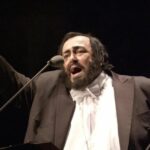
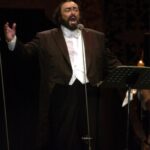
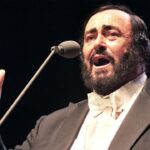
Лучано Паваротти не только вошел в ТОП-3 лучших оперных певцов планеты, но и популяризировал этот вид вокального искусства. Доказательством тому является полумиллионная аудитория, в разные года посетившая выступления певца в Лондонском Гайд-парке, Марсовом поле в Париже и Центральном парке Нью-Йорка.
В 1992 году Лучано создает креативный медийный проект «Паваротти и друзья», в котором, помимо известных оперных певцов, принимают участие такие «звезды» эстрады, как сэр Элтон Джон, Брайан Адамс, Стинг, Селин Дион, Бочелли, Лайонел Ричи и Шерил Кроу. В 1998 году Паваротти становится обладателем престижной международной премии Grammy Legend Award («Легенда Грэмми»).
Личная жизнь
Со своей будущей супругой, Адуа Верони, Лучано знакомится в период своей преподавательской деятельности в Модене. В брак молодые люди вступают в 1961 году, когда певец делает первые уверенные шаги в покорении оперной сцены. Спустя год (в 1962 году) у счастливых молодоженов рождается дочь Лоренца, в 1964 Кристина, а в 1967 — Джулиана.
Союз с Адуа был крепким. Вместе супруги прожили более 40 лет. Однако, постоянные измены Лучано стали причиной их развода. За время музыкальной карьеры тенор состоял в романтических отношениях со многими именитыми женщинами. Одним из самых ярких и известных романов Паваротти в 90-ых годах была его любовная связь с ученицей по имени Мадлен Рени.
Свою последнюю любовь Лучано встретил в 60 лет. И именно она подарила ему «вторую жизнь». Молодую возлюбленную, которая на 36 лет была младше маэстро, звали Николетта Монтовани. Предложение избраннице Паваротти сделал в 2000 году и сразу же приступил к строительству семейного особняка. Спустя три года совместной жизни у пары рождаются близнецы — дочь Элис и сын Рикардо. К несчастью для родителей, мальчик вскоре умирает, и Лучано отдает все силы для достойного воспитания маленькой дочери.
Смерть певца
В 2004 году у артиста обнаруживают рак поджелудочной железы. Взвесив все «за» и «против», Паваротти организовывает прощальный тур по 40 мировым столицам. В 2005 году маэстро записывает студийный альбом под названием Тhe best. В сборник входят лучшие арии великого тенора, когда-либо исполненные им на сцене. Финальное выступление Паваротти на публике состоялось 10 февраля 2006 года на открытии Олимпиады в Турине.
После операции по удалению саркомы состояние Лучано значительно улучшается. Однако, в период реабилитации (в августе 2007 года) он заболевает пневмонией. После госпитализации и прохождения курса лечения Лучано возвращается в дом в Мадене, где умирает 6 сентября 2007 года. В течение трех дней после смерти маэстро, пока гроб с его телом находился в местном соборе, попрощаться с кумиром пришли десятки тысяч человек.
Партиии
- «Пуритане»
- «Сомнамбула»
- «Капулетти и Монтекки»
- «Аида»
- «Травиата»
- «Риголетто»
- «Трубадур»
- «Макбет»
- «Луиза Миллер»
- «Ломбардцы в первом крестовом походе»
- «Бал-маскарад»
- «Отелло»
- «Дон Карлос»
- «Эрнани»
- «Андре Шенье»
- «Дочь полка»
- «Фаворитка»
- «Лючия ди Ламмермур»
- «Паяцы»
- «Любовный напиток»
- «Мария Стюарт»
- «Сельская честь»
- «Друг Фриц»
- «Манон»
- «Идоменей, царь Критский»
- «Джоконда»
- «Манон Леско»
- «Мадам Баттерфляй»
- «Богема»
- «Вильгельм Телль»
- «Кавалер розы»
Ссылки
- Страница в Википедии
Для нас важна актуальность и достоверность информации. Если вы обнаружили ошибку или неточность, пожалуйста, сообщите нам. Выделите ошибку и нажмите сочетание клавиш Ctrl+Enter.
Биография
Лучано Паваротти — выдающийся тенор второй половины XX столетия. При жизни слава маэстро гремела на весь мир, а его концерты неизменно проходили при полном зале. Но даже после смерти исполнитель остается эталоном оперного пения для преданных поклонников, количество которых продолжает расти.
Детство и юность
Лучано родился 12 октября 1935 года в итальянском городе Модене. Отец, Фернандо Паваротти, работал пекарем, но пение было его главным увлечением. Он не стал профессиональным певцом только потому, что испытывал страх перед сценой. Мать мальчика Адель Вентури работала на табачной фабрике. Помимо сына, в семье подрастала дочь Гарбиэлла, ставшая профессиональной волейболисткой.
В 1943 году семья перебралась на загородную ферму. Там родители Лучано занимались сельским хозяйством. В этот период у него уже обнаружился талант к пению. В четыре года малыш устраивал импровизированные концерты для соседей.
Когда артист стал старше, он начал петь в церковном хоре вместе с отцом. Дома мальчик постоянно прослушивал пластинки оперных певцов из коллекции Фернандо, а в 12 лет впервые попал в театр, где услышал выступление тенора Беньямино Джильи. Это событие стало знаменательным, и с тех пор Лучано всерьез раздумал о карьере исполнителя.
После получения среднего образования мать убедила сына выучиться на педагога. Некоторое время Паваротти работал в школе учителем начальных классов, позже стал страховым агентом. В это же время он начал брать уроки у Арриго Пола, а когда тот отбыл в Японию, — у Эттори Кампогаллиани. Будучи знаменитым артистом, он не переставал благодарить своих преподавателей, способствовавших его становлению в качестве маэстро оперной сцены.
Музыка
Сценическая карьера исполнителя едва не оборвалась еще в самом начале. В молодости Лучано перенес ларингит, после чего у него обнаружили утолщение связок. Он больше не мог петь, поэтому был вынужден прекратить занятия музыкой, испытав фиаско во время концерта в Ферраре. Но год спустя утолщение исчезло, а голос тенора приобрел новые краски и глубину.
Embed from Getty Images
В 1961-м Паваротти победил на международном вокальном конкурсе. Первую премию он разделил с сыном Владимира Набокова Дмитрием. Молодые вокалисты получили партии в опере «Богема» Джакомо Пуччини, с которыми выступили в театре Реджио Эмилия. Спустя годы артист назвал это произведение своей первой любовью.
Вскоре после этого Лучано выпала возможность исполнить партию Рудольфа из «Богемы» на сцене Венской государственной оперы. Это позволило обратить на себя внимание европейской публики, ведь до этого тенор был известен только в родной Италии.
7 интересных фактов из жизни Лучано Паваротти
На мировой арене Паваротти прославился благодаря появлению в лондонском Ковент-Гардене. Он заменил на сцене внезапно заболевшего соотечественника Джузеппе Ди Стефано. Вместе с выступлением в театре последовало приглашение на британское телешоу Sunday Night at the Palladium, которое посмотрели около 15 млн зрителей.
В 1965-го Лучано впервые посетил США, куда отправился вместе с Джоан Сазерленд. В Майами артист исполнил партию Эдгара в трагической опере «Лючия ди Ламмермур» под руководством мужа певицы Ричарда Бонинга, с которым впоследствии неоднократно сотрудничал.
Дальнейшему карьерному успеху Паваротти способствовало подписание контракта с импресарио Гербертом Бреслином, который занялся продвижением тенора в лучших театрах мира. В 1966-м маэстро дебютировал в миланском Ла Скала.
Параллельно с участием в спектаклях Лучано активно гастролировал с сольными концертами, в которые входили классические оперные арии, итальянские песни и концоны. Его исполнению композиций Caruso и Ave Maria публика рукоплескала стоя.
В 1972 году в нью-йоркской Метрополитен-опере состоялось сенсационное выступление артиста. Во время исполнения партии Тонио из «Дочери полка» он установил своеобразный рекорд: спел подряд девять высоких нот до на полной мощности голоса с безупречной легкостью.
В новом десятилетии маэстро основал международный конкурс вокалистов Паваротти. В разные годы тенор ездил в гастрольные туры по Америке и Китаю, где вместе с молодыми дарованиями исполнял фрагменты из мировых опер.
Он продолжал устанавливать личные рекорды, собирая на своих выступлениях сотни тысяч слушателей. В 1980-м насладиться выступлением звезды в нью-йоркском Центральном парке пришли 200 тысяч человек, а 13 лет спустя удалось собрать уже полмиллиона.
Но в карьере исполнителя не обходилось и без провалов: в 1992 году, во время участия в опере «Дон Карлос» Джузеппе Верди, поставленной Франко Дзеффирелли в Ла Скала, публика освистала Паваротти. Сам тенор признавал вину и больше в этом театре не выступал.
Новый виток международного признания итальянского оперного певца произошел в 1990 году, когда компания ВВС сделала заставкой трансляции чемпионата мира по футболу арию Nessun Dorma в исполнении Паваротти, Пласидо Доминго, Хосе Каррераса. Видео для клипа было снято в термах Каракаллы. Тираж распроданных записей стал самым большим за всю историю музыки, что зафиксировано в книге рекордов Гиннесса.
Лучано популяризировал оперу. В 1992 году он создал благотворительную программу «Паваротти и друзья», объединив оперное пение и творчество ярчайших представителей рок- и поп-музыки. Поклонники остались в восторге от дуэтов с Элтоном Джоном, Брайаном Адамсом, Стингом и Джеймсом Брауном.
В 2000-х Паваротти радовал публику реже — здоровье подводило его. Но он настолько любил музыку, зрителей, сцену, что даже после официального прощания планировал вернуться к творчеству. Но случиться этому было не суждено. Последнее выступление итальянской звезды состоялось в 2006 году на церемонии открытия XX зимних Олимпийских игр в Турине.
Личная жизнь
Еще учась в школе, Лучано познакомился со своей будущей женой Адуа Верони, которая также увлекалась пением. Молодые люди смогли пожениться в 1961 году, как только Паваротти начал самостоятельно зарабатывать. Жена родила знаменитости троих детей — Лоренцу, Кристину и Джулиану.
Брак с Адуа просуществовал около 40 лет, но все это время в прессе писали о многочисленных изменах артиста. Паваротти за время музыкальной карьеры встречался с многими певицами. Обсуждаемым романом периода 80-х годов была его связь с ученицей Мадлен Рени.
В 60 лет тенор, как утверждал в интервью, встретил девушку, которая подарила ему вторую молодость. Николетта Монтовани работала у исполнителя секретаршей и была на 36 лет младше его. Именно их совместные фото, опубликованные в газетах, вынудили Адуа подать на развод.
Embed from Getty Images
После этого маэстро обрел счастье в личной жизни, женившись на своей молодой избраннице. Еще до официального вступления в брак у них родились близнецы — сын Риккардо и дочь Элис, но новорожденный мальчик умер. Паваротти посвятил себя воспитанию наследницы. Он мечтал, что она тоже станет оперной певицей.
Смерть
В 2004-м Лучано поставили неутешительный диагноз — рак поджелудочной железы. После этого артист отправился в прощальный тур по 40 городам мира. Также он выпустил диск Тhe Best, в который вошли лучшие номера, когда-либо им исполненные.
Певцу провели операцию по удалению опухоли. Состояние маэстро улучшилось, но в августе 2007 года он перенес пневмонию. Вернувшись домой в Модену, артист скончался 6 сентября, причиной смерти стало ослабление организма на фоне перенесенных болезней.
Похоронили знаменитость на кладбище Монтале Рангоне. В течение трех дней, пока гроб с телом Лучано стоял в соборе родного города, круглосуточно шли люди, чтобы проститься с кумиром.
Дискография
- 1990 — The Essential Pavarotti
- 1992 — Pavarotti & friends
- 1994 — Dein ist mein ganzes Herz
- 1995 — Pavarotti & friends 2
- 1998 — The Three Tenors: Paris
- 1999 — Christmas with Pavarotti
- 2000 — The Three Tenors Christmas
- 2001 — Donizetti Arias
- 2001 — Neapolitan and Italian Popular Songs
Интересные факты
- Певец был поклонником футбола и в юности даже хотел стать профессиональным игроком. Он болел за «Ювентус» и в свободное время любил пересматривать старые матчи.
- В 2019 году вышел документальный фильм «Паваротти» Рона Ховарда, посвященный биографии тенора.
- В интервью Лучано признавался, что из всех опер психологически ему близок герой «Любовного напитка».
Биография Лучано Паваротти
Паваротти Лучано (Pavarotti, Luciano) (р. 1935), итальянский тенор, один из самых популярных у публики и безусловно признаваемых критикой оперных теноров в эпоху после Э.Карузо. Среди достоинств пения Паваротти – превосходная высокая постановка голоса; солнечный полетный тембр; на редкость совершенное вокальное мастерство и как следствие легкость звукоизвлечения. Сочетание подобных качеств с невероятно сильной индивидуальностью, излучающей тепло и жизнерадостность, сделали певца одной из «суперзвезд» оперной сцены 20 столетия.
Выступление на концерте в честь официального открытия Константиновского дворца. Стрельна, Санкт-Петербург, 31 мая 2003
Паваротти родился 12 октября 1935 в Модене (Италия). После окончания школы в Модене начал заниматься вокалом в Мантуе у Э.Кампогальяни. Дебютировал в 1961 в партии Родольфо в Богеме Пуччини. Через пять лет был уже подготовлен к дебюту в миланском театре «Ла Скала» (партия Тибальда в Капулетти и Монтекки Беллини). Но только партия Тонио в Дочери полка Доницетти (спетая сначала в театре «Ковент-Гарден» в 1966, а потом, в 1972, на сцене нью-йоркской «Метрополитен-опера») принесла Паваротти международную известность и титул «Короля верхнего до» (ноты до второй октавы – он стал первым тенором в истории оперы, который спел все девять высоких до в арии Quel destin).
Лучано Паваротти в детстве
Хотя основная специальность Паваротти – лирические белькантовые партии (Эльвино в Сомнамбуле Беллини, Артуро в его же Пуританах, Эдгардо в Лючии ди Ламмермур Доницетти, Альфред в Травиате Верди, Герцог Мантуанский в его же Риголетто), со временем певец стал обращаться и к более драматическим ролям, таким, как Риккардо в Бале-маскараде Верди, Каварадосси в Тоске Пуччини, Манрико в Трубадуре Верди, Радамес в его же Аиде.
Успех Паваротти у публики набирал силу в течение 1970–1980-х годов, поддерживаемый частыми выступлениями певца по телевидению и его стремлением, давая сольные вечера и выступая в смешанных концертах, донести оперное искусство до людей, которые редко посещают оперный театр или никогда не переступали его порога. В 1990-е годы певец собирал сотни тысяч слушателей на свои концерты на стадионах и в парках.
История жизни Лучано Паваротти
В детстве Лучано больше всего любил ловить лягушек и ящериц, играть в футбол — ну и, конечно, петь. Впрочем, в Италии, как известно, поют все. Отец Лучано приносил домой пластинки знаменитых теноров — Джильи, Карузо, Мартинелли, и вместе с сыном они слушали их буквально до дыр. Лучано забирался на стол в кухне и голосил во все легкие «Сердце красавицы». В ответ на его истошное пение одновременно из 15 соседних квартир раздавались не менее истошные крики: «Баста! Да замолчи же ты, наконец!!!»
Лучано Паваротти в молодости
Позже — уже в школе — Лучано начал петь в церковном хоре. Ему было 12 лет, когда на гастроли в местный театр приехал тенор Беньямино Джильи. Лучано пробрался в театр во время репетиции. «Я тоже хочу стать певцом!» — выпалил он Джильи, пытаясь таким образом высказать свое восхищение. Хотя на самом деле хотел стать футболистом. Футболиста из него, как известно, не вышло. В 1961 году Лучано Паваротти занял первое место на конкурсе вокалистов в Реджо-нель-Эмилия, в том же году состоялся его дебют в «Богеме» Пуччини.
Три тенора: Лучано Паваротти, Хосе Каррерас и Пласидо Доминго
А через два года сбывалась заветная мечта молодого певца: он стал солистом всемирно известного оперного театра «Ла Скала» и начинал триумфальное шествие по сценам и концертным залам мира. На одном из своих выступлений в «Метрополитен-опера» Паваротти довел зрителей до состояния полной эйфории, так что занавес пришлось поднимать 160 раз — что и было занесено в Книгу рекордов Гиннесса.
Друзья называют Паваротти «Big P». «Большой» — не в смысле «великий», а в самом что ни на есть буквальном смысле. Правда, при этом близкие Паваротти в один голос говорят, что в нем 150 килограммов чистого обаяния и добродушия. То есть 150 плюс-минус 10. Диетические испытания, выпадающие на долю Паваротти, регулярно тиражируются в прессе и уже, пожалуй, имеют хождение в категории анекдотов. Да, габариты Паваротти — проблема для портных и беда для стульев. Чего стоит хотя бы петь партию Каварадосси в опере Пуччини «Тоска».
Во втором акте его героя после пыток приводят в кабинет, и он так измучен, что еле держится на ногах и падает на стул. Уже во время репетиций Паваротти с опаской посматривал на этот стул из резного дерева, затем подошел к режиссеру и тихо, чтобы никто не слышал, сказал: «Думаю, этот стул меня не выдержит». Режиссер заверил его, что волноваться нечего, стул заблаговременно укрепили металлом. Генеральную репетицию стул действительно выдержал. Наступил день премьеры. Второй акт. Стражники вытащили Паваротти под руки и усадили его на стул. Хильдегард Беренс, выступавшая в партии Тоски, должна была подойти к своему возлюбленному и обнять его. Но так вошла в роль, что разбежалась через всю сцену и бросилась ему на шею. Того, что произошло вслед за этим, на сцене «Гранд-опера» не бывало никогда: стул с треском развалился, вместе с ним грохнулся Паваротти—Каварадосси, а сверху приземлилась и Тоска.
Пласидо Доминго, Лучано Паваротти, Хосе Каррерас
«Почему я так много ем?» — Лучано на вечный вопрос корреспондентов отвечал. — Во-первых, я итальянец. Во-вторых, я родом из Модены — города обжор». Что поделаешь — это в его стиле: поселить в доме консультанта-диетолога и платить ему бешеные суммы за каждые сутки, а затем, лишь только тот переступит порог, броситься на кухню и опустошить холодильник. «Я самый тяжеловесный рэппер в мире», — так великий тенор прокомментировал свои выступления вместе с поп- и рок-звездами: Дзуккеро, Стингом, Брайаном Адамсом, ирландской группой «U2». Записи концертов «Паваротти и друзья» разошлись миллионными тиражами по всему миру.
Лучано и Адуа познакомились еще подростками и были семь лет помолвлены до того, как поженились. Свадьба состоялась в 1961 году, когда Лучано получил первый приличный гонорар и, говорят, даже пытался оклеить купюрами стены спальни, но впоследствии употребил их все же на то, чтобы купить свой первый автомобиль. Кстати, именно Адуа Паваротти обязан тем, что стал певцом, а не учителем в народной школе. В свое время она уговорила его брать уроки вокала.
Лучано Паваротти и Адуа Верони
«Немногие женщины могли бы примириться с жизнью оперного певца, как смогла это сделать Адуа«, — написал Лучано Паваротти в своей книге. Она не жаловалась ни на то, что их дом был скорее похож на проходной двор, ни на то, что видела своего супруга самое большее 5 дней в месяц. «За все время нашей совместной жизни я больше разговаривала с ним по телефону, — говорила Адуа Паваротти, — чем виделась с мужем. Кстати, именно по телефону он узнал о рождении наших дочерей«.
Жизненное кредо своего уже бывшего супруга она определила так: «Спагетти, спагетти, потом — любовь«, — а на вопрос корреспондента, как она относится к тому, что во время поездок Паваротти окружает столько красивых женщин, Адуа несколько лет назад ответила: «Ничего страшного, если он посмотрит на хорошенькое личико. Все равно он выберет пиццу«. Увидев растиражированные по всему свету фотографии 61-летнего Паваротти и его 27-летней секретарши Николетты Мантовани, нежащихся в Карибском море, Адуа в этом усомнилась. Эта Николетта не может не нравиться. Красивое личико с неотразимой улыбкой, как, впрочем, и у ее соблазнителя. И при этом совсем не глупа. В Болонье она изучала науки, стала хорошим психологом. Ведь она оказалась единственным человеком, утешившим Лучано, когда итальянская команда проиграла матч на Кубок мира по футболу. Разве это не так важно? А может ли кто-нибудь усомниться в ее подвиге, когда она прогнала эту ужасную змею, незаметно пробравшуюся в комнату божественного тенора в Бали?
Лучано Паваротти и Николетта Монтовани
Кто же устоит перед столь могущественной Венерой? Конечно, это не первая пощечина, нанесенная мягкотелым героем семейному миру и благополучию. Он постоянно пел дифирамбы своей законной и прямо-таки незаменимой супруге, умело правившей империей Паваротти. Сейчас перед этим вечным странником открылось свободное поле деятельности.
Адуа, управлявшая колоссальным состоянием этого добряка-гиганта, конечно, на все его похождения закрывала глаза. Однажды Ватикан даже запретил Лучано участвовать в торжественной мессе в нью-йоркском Централ-Парке, а супруга сделала вид, что равнодушна к статьям, появившимся на этот счет в прессе. Но на сей раз Адуа взбесили заполонившие прессу фотографии двух голубков, резвящихся в теплых водах у берегов Барбадоса. Эта Николетта, разве она не твердит на всех перекрестках, что мечтает родить Паваротти сына? Не издевательство ли это над ее тремя дочерьми? В ярости Адуа сорвала табличку с фамилией Паваротти с дверей дома в Саличета близ Модены, где обитает весь их клан. На дверях осталась только ее фамилия: Адуа Верони. Письмо, которое еще больше разожгло скандал, разгневанная Юнона передала через своего адвоката. Его можно считать шедевром дипломатии.
«Для любого создания, таков непреложный закон бытия, путь к успеху становится все более размытым. Когда спускаются сумерки, — написала она мужу с чарующей предупредительностью, — чувство конца и одиночества, особенно часто посещающее людей, имевших успех в жизни, можно подавить другими, глубоко укоренившимися чувствами, выдержавшими испытание временем«.
Вместе с тем Адуа совершенно бескорыстна: чета Паваротти заключила брак на условиях раздельного владения имуществом, и вопрос о разводе (по-итальянски) в данный момент не стоит. Лучано Паваротти дал интервью журналу «Frau im Spigel»: «Маэстро, психологи расценивают ваш выбор столь молодой женщины в качестве спутницы жизни как бегство от своего возраста. Что вы на это скажете?» «Почему бы и нет? У меня было чудесное детство с прабабушкой, бабушкой, мамой, тетками. У меня была прекрасная жизнь с моей женой и дочерьми. Мне удалось сделать фантастическую карьеру. Сейчас я решил начать новую жизнь вместе с Николеттой. Я уверен, она будет столь же прекрасна, как и все в моем прошлом. Может, ваши психологи имеют что-нибудь против человеческого счастья и радости?» «Когда ваша любовная история с секретаршей стала достоянием общественности, вы как раз должны были петь в «Метрополитен-опера». Вы не боялись негативной реакции публики?»
«Это был чистый кошмар! Некоторые люди не умеют отличать личное от профессионального, сваливают все в одну кучу и думают, что, если певец отдал свое сердце молодой женщине, это должно сказаться и на его творческом мастерстве, причем в худшую сторону. Сплетни и злословие в прессе и враждебное настроение публики — это была чудовищная нагрузка перед премьерой. Но я выдержал и это испытание«.
«Вы похудели на 15 килограммов. Заслуга Николетты?» «Совершенно верно. Она заперла меня дома на три недели наедине с планом диетического питания и соответствующими ему продуктами. Ни спагетти, ни пиццы, ни алкоголя… Сплошной сок, да еще водой разбавленный». «А как складываются отношения с вашей бывшей женой?» «Мирно. С дочерьми тоже нет проблем — они умные девочки и очень меня любят». «У вас с Николеттой полное взаимопонимание или все же бывают какие-либо разногласия?» «По поводу еды — постоянно. Ее кулинарные способности — сплошная катастрофа. Как-то она собралась приготовить мне тортеллини. Для этого ей понадобилось звонить из Нью-Йорка, где мы находились, своей матери в Болонью — чтобы узнать рецепт. Разговаривали они почти час. Очень, конечно, мило с ее стороны, но гораздо дешевле было бы слетать в Италию». «Вы не собираетесь обзаводиться ребенком?» «Обязательно. Я бы очень хотел мальчика, ведь всю жизнь я был окружен одними женщинами. Но мы подождем еще пару лет: 29 апреля 2001 года я отпраздную 40-летие моей творческой деятельности и уйду «на пенсию» — буду преподавать вокал. Самое время, чтобы снова стать отцом«.
Похороны Лучано Паваротти
В 2004 году Лучано ставят неутешительный диагноз – рак поджелудочной железы. Артист, взвесив все возможности, решается на проведение последнего прощального тура по 40 городам мира. В 2005 году выходит диск певца Тhe best, в который вошли лучшие номера, когда-либо исполненные Паваротти. Последнее выступление великого тенора состоялось 10 февраля 2006 году на туринской Олимпиаде, после чего Паваротти лег в больницу на операцию по удалению ракового образования.
Состояние Лучано улучшилось, но в августе 2007 года певец перенес пневмонию. Вернувшись домой в Мадену, артист скончался 6 сентября 2007 года. Смерть маэстро не могла оставить равнодушными его поклонников. В течение трех дней, пока гроб с телом Лучано Паваротти стоял в соборе родного города, круглосуточно шли люди, чтобы проститься с кумиром.
Лучано Паваротти (Luciano Pavarotti) – мировая знаменитость, оперный певец Италии с исключительным слухом и голосом широкого диапазона. Участник проекта “Три тенора”, выступал на сцене больше 40-ка лет, давал мастер-классы в нескольких консерваториях по всему миру.
Биография
Лучано Паваротти появился на свет 12 октября 1935 года в итальянском регионе Эмилия-Романья (Emilia-Romagna), в Модене (Modena).
Семья
Глава семейства Фернандо (Fernando) работал на пекарне и страстно любил музыку, мать Адель Вентури (Adele Venturi) была работницей на фабрике сигарет. Семья жила бедно, занимая маленькую квартирку из двух комнат, но детство Лучано и его младшая сестренка Габриэлла (Gabriella, 1940 – 2013) вспоминали с теплотой. Мальчик был единственным ребенком мужского пола в доме из 15-ти квартир, где они проживали, и привык к особому вниманию.
Фернандо Паваротти имел хороший тенор, но плохой характер и поэтому не стал популярным певцом, хотя и был участником моденского хора “Корала Росси” (“Coral Rossi”) . В его коллекции находилось много пластинок с записями Беньямино Джильи (Beniamino Gigli), Энрико Карузо (Enrico Caruso), Тото Скипа (Attilio Schipa), которые он слушал каждый день вместе с сыном.
Детство и юность
Мальчик, как и все итальянцы, любил музыку, все время пел и мечтал стать знаменитым. Используя вместо сцены кухонный стол, он забирался на него и громко пел арию “La donna è mobile” (“Сердце красавицы”) герцора Мантуанского из оперы Джузеппе Верди (Giuseppe Verdi) “Риголетто” (“Rigoletto”). Первые слушатели Лучано, соседи многоквартирного дома, не желали слушать эти вопли и требовали тишины.
Но пока что маленькому мальчику было интереснее не заниматься музыкой, а отлавливать ящериц с лягушками и играть в футбол.
Во Время второй мировой войны наступили трудные дни и семья приняла решение сменить место жительства. В 1943 г. они поселились в деревне неподалеку, сняв небольшую комнатушку на всех и начав работу на фермерском подворье.
Обучаясь в школе, Лучано, по желанию родителей, стал ходить с отцом петь в церковь. Но любовь к футболу брала свое и молодой человек становится капитаном юношеской команды города. Его жизнерадостность и вера в победу передавались всей команде, приводя к победам.
Поиск себя
Закончив школу Scuola Magistrale Лучано жаждет поступить в Спортивную Академию и всерьез подумывает стать вратарем. Однако, родители не разделяли намерений сына и убедили его, что быть учителем начальных классов лучше и серьезнее. Целых два года молодой педагог преподавал детям в школе. Паваротти не нравилась эта работа, дети иногда не слушались и приходилось на них кричать, срывая голос. А ему хотелось петь.
В 19 лет, в 1954 году, Лучано начинает петь вместе с отцом в хоре “Корала Росси”. Глава семьи говорил, что его сын – не Карузо и ему нужна более серьезная профессия. По просьбе сына отец с трудом, но все же соглашается помогать ему материально до достижения последним 30-летнего возраста. Потом Лучано должен был зарабатывать себе на жизнь любыми способами самостоятельно.
Будущая звезда начинает ходить на уроки тенора Арриго Пола (Arrigo Pola), который заметив у Лучано голос необычайной красоты и удивительный слух соглашается на бесплатные занятия с юношей, ввиду тяжелого материального положения семьи.
В 1955 году хор из маленького городка занимает призовое место на конкурсе исполнителей Eisteddfod в Уэльсе (Wales), Лучано окрыляется достигнутым успехом и принимает окончательное решение стать певцом. В это же время он знакомится с будущей женой – начинающей оперной певицей Адуа Верони (Adua Veroni) и вскоре они объявляют о помолвке.
В 1956 г. А. Пола покидает Италию и уезжает на постоянное место жительства в Японию. Наставником Паваротти становится Эттори Кампогаллиани (Ettore Campogalliani).
Обучаясь музыке Лучано продолжал преподавать в школе, потом перешел в сферу страхования. 6 лет учебы не были ознаменованы какими-нибудь яркими событиями музыкальной карьеры. Паваротти дал несколько концертов с бесплатным входом в небольших городках и на этом все.
Один из таких концертов в Ферраре (Ferrara), прошел с провалом: на голосовых связках тенора появилась складка и он решил, что больше не будет заниматься музыкой. Но его будущая жена, уговорила Лучано не делать этого. Через некоторое время складка прошла, а голос певца зазвучал еще сильнее и лучше.
Карьера
В 1960 году начинающий певец становится участником конкурса Главного городского театра – Teatro Reggio Emilia. Он хочет получить главную роль в новой опере, но заболевание горла не позволило вытянуть все ноты.
В 1961 г. Лучано повторяет попытку, побеждает и получает партию Рудольфа в “Богеме” (“La Bohème”) Джакомо Пуччини (Giacomo Puccini).
Вместе с ним в конкурсе участвует Дмитрий Набоков, сын Владимира Набокова. Отец со всей ответственностью запечатлел для потомков выступление сына, на пленке оказался и Паваротти.
Весь гонорар от первой премьеры Паваротти тратит на свадьбу с Адуа.
Солист оперных театров
- В 1962 г. Паваротти выступил в национальном театре Белграда в Югославии исполнив партию Альфредо из”Травиаты” (“La traviata”) Джузеппе Верди.
- В 1963 г. певец стал дебютантом в театре “Covent Garden”. Тенор Джузеппе ди Стефано (Giuseppe Di Stefano) не смог спеть уже знакомую Паватории партию Рудольфа в связи с недомоганием. Лучано успешно и с удовольствием заменяет больного.
- В 1963 г. он впервые выступает с той же арией в “Wiener Staatsoper”.
- В 1963 г. в Ирландии организован 1-й сольный концерт Лучано Паваротти.
- В 1965 г. Паваротти предложили выйти на сцену “Florida Grand Opera” в Майами, где он вновь заменяет тенора, спев арию Эдгара в опере “Лючия ди Ламмермур” (“Lucia di Lammermoor”) композитора Гаэтано Доницетти (Gaetano Donizetti). Его партнером по сцене стала сопрано Джоан Сазерленд (Joan Sutherland). Голос Лучано Паваротти так понравился австралийской певице, что она предложила ему организовать совместный тур. За 2 месяца они выступили на 40 концертах, что позволило растущему тенору набраться огромного вокального опыта и опыта выступлений.
- В 1966 г. Паваротти достиг своей заветной мечты, он принят солистом мирового центра оперной культуры в Италии – театра Ла Скала (Teatro alla Scala или La Scala), исполнив партию Тибальда в опере “Капулетти и Монтекки” (“I Capuleti ed i Montecchi”) Винченцо Беллини ( Vincenzo Bellini). До этого его дважды не принимали в театр, но дирижёр Герберт фон Караян (Herbert von Karajan) добился того, что Паваротти взяли на подмену. Позже Караян назовет его лучшим тенором мира.
- В 1967 г. партию Тонио (ария “Quel destin”), в исполнении Паваротти в опере “Дочь полка” (” La figlia del reggimento”) композитора Гаэтано Доницетти (Domenico Donizetti ), пришел слушать в “Covent Garden” весь городской бомонд. С этого дня Лучано получил звание “короля верхнего до”: он без труда, легко и непринужденно исполнил все 9 верхних “до” подряд. Зал замер, раньше такого не мог сделать ни один певец.
- В 1968 г. Лучано Паваротти 1-й раз выступил в нью-йоркской “Metropolitan Opera”. Он повторил успех арии “Quel destin” и ему аплодировали так неистово, что театр заставляли открывать занавес 160 раз. Этот момент не остался без признания и был записан в Книгу рекордов Гиннесса.
Так, начиная с лирических арий (Эльвино в “Сомнамбуле” (“La sonnambula”) и Артуро в “Пуританах” (“I puritani”) композитора Беллини, герцог Мантуанский в “Риголетто” (“Rigoletto”) Верди), постепенно Паваротти приходит к драматическим ариям (Риккардо в “Бале-маскараде” (“Un ballo in maschera”), Манрико в “Трубадуре” (“Il trovatore”) и Рамадес в “Аиде” (“Aida”) Верди, Каварадосси в “Тоске” (“Tosca”) Пуччини). Но наступает время когда тенору становится мало стен театров.
Всемирная известность
В 1970-80 гг. Паваротти становится медийной личностью. Его все время показывают по телевидению, он дает сольные концерты в концертных залах и парках, участвует в смешанных номерах. Лучано становится постоянным участником фестиваля “Arena di Verona” и выступает на одноименной арене.
В 1974 г. тенор впервые посетил Моску с театром “La Scala”.
В 1980 г. концертная постановка “Риголетто” в центальном нью-йоркском парке транслируется для аудитории в 200 тысяч слушателей. После этого итальянец выступает основателем международного конкурса для неизвестных талантов вокала (“The Pavarotti International Voice Competition”). Финалистам конкурса предоставляется возможность петь вместе с маэстро в Модене, Пекине и Филадельфии.
В 1984 г. Лучано Паваротти выступает в “Covent Garden” перед царственной четой Дианой и Чарльзом, после чего начинается их дружба. Однако, на похоронах Дианы итальянец петь отказывается, так как принял трагедию близко к сердцу.
В 1988 г. тенор побивает свой рекорд, выступая в “Deutsche Oper Berlin”. “Любовный напиток” (“L’elisir d’amore”) Г. Доницетти с его участием прошел так блистательно, что занавес открывали 165 раз!
Три тенора
Ария “Nessun Dorma” из «Турандота» Дж. Пуччини вновь приносит ему славу в 1990 г., но уже не театральную, а в кругах поп-культуры. Песня прозвучала на открытии кубка FIFA, после чего стала хитом.
На финальном матче турнира был дан 1-й концерт “Трех теноров”: Пласидо Доминго (Plácido Domingo), Хосе Каррераса (José Carreras), Лучано Паваротти. Фоном для их выступления стали старинные римские термы Каракаллы (Terme di Caracalla).
Запись выступления побила все мировые рекорды по продажам музыки, что тоже отмечено в Книге рекордов. Трио еще несколько раз выступало на футбольных чемпионатах: в США в 1994 г., во Франции в 1998 г., в Японии в 2002 г. Проект “Три тенора” просуществовал 15 лет и имел ошеломительный успех по всему миру. Оперные певцы смогли донести серьезную музыку до широких масс, выйдя из стен театра.
В 1992 г. Лучано Паваротти последний раз поет в “Ла скала” в “Дон Карлосе” (“Don Carlo”) композитора Франко Дзеффирелли (Franco Zeffirelli). Это единственный случай, когда ни зрителям, ни критикам выступление не понравилось.
Паваротти и друзья
Выступления с известными поп- и рок-музыкантами на благотворительных концертах “Паваротти и друзья” начались с 1992 г. и проводились до 2005 г.
Вместе с тенором пели: Дзуккеро (Zucchero), Брайан Мэй (Brian May), Стинг (Sting), Роджер Тейлор ( Roger Taylor), Селин Дион (Céline Dion), Брайан Адамс (Bryan Adams), группа “U2”, Мерайя Кэри (Mariah Carey) и другие знаменитости.
Денежные сборы с концертов шли на оказание помощи беженцам по всему миру. Альбомные концертные записи стали сюрпризом для меломанов и расходились огромными тиражами.
Прощание со сценой и жизнью
В 2004 году тенор официально попрощался со сценой. Ария Каварадосси из оперы “Тоска” Лучано Паваротти исполнена после сообщения гостям нью-йоркской “Metropolitan Opera” о последнем выходе итальянца. В зале был аншлаг, а заслуженного певца проводили оваций, которая длилась 11 минут.
10 февраля 2006 года в Турине (Torino) он последний раз пел на открытии Олимпийских игр.
В том же году у Паваротти обнаружена злокачественная опухоль на поджелудочной железе. Он перенес операцию по удалению новообразования. 8 августа 2007 года тенора госпитализируют в больницу с температурой, в стационаре он находится 2 недели.
6 сентября 2007 года в 5 часов утра Лучано Паваротти умер у себя дома. По завещанию, его похоронили на кладбище “Montale Rangone” в склепе семьи, где находились родители Паваротти и сын от второй жены.
Семья
Первая жена Адуа была для Лучано ангелом-хранителем, верной спутницей, помощницей и хранительницей очага. Рождение первой дочери Лоренцы (Lorenza) в 1962 г. новоиспеченный папа пропустил, потому что не ночевал дома. Он с друзьями всю ночь праздновал свой успешный дебют в “Риголетто”. В 1967 г. Адуа родила Кристину (Cristina), в 1967 г. – Джулиану (Giuliana). И все эти новости отец семейства узнавал по телефону. Примерным отцом он тоже не стал.
После развода Адуа сокрушалась, что ее экс-муж мог провести в яслях больной кобылы всю ночь, если ей нездоровилось, но никогда не сделает такого ни для одной из своих дочерей.
Многочисленные романы любвеобильного мужа не вызывали гнева у его мудрой жены. Пока супруг зарабатывал миллионы, она их вкладывала: в недвижимость, в акции, в предприятия. Она знала все о его доходах. При этом свое развратное поведение Лучано заглаживал дорогими подарками.
Чтобы жена не препятствовала его роману с секретаршей Мадлен Рени (Madeline Renee) длиной в 7 лет, он презентовал супруге браслет стоимостью 250 тысяч долларов. Впоследствии Мадлен нашла себе другого мужчину и они обвенчались, а Паваротти чуть не выбросился из окна, когда узнал об этом.
Многие из секретарш Лучано побывали не только в рабочих отношениях со своим боссом, но никто из них не афишировал этого так как Николетта Мантовани (Nicoletta Mantovani). Ей было 27 лет, Паваротти 61 и их фотографии с Барбадоса были растиражированы по всей Италии. Лучано открыто сказал, что счастлив с девушкой, которая моложе его младшей дочери. Николетта, в свою очередь, всем и каждому говорила, что хочет родить ему сына.
В марте 1996 г. супруги Паваротти объявили, что больше не вместе. Адуа выгнала Лучано из дома. Развод был громким и официально состоялся через 6 лет. Сложностей с разделом имущества возникло много, так как брак был заключен на условиях раздельного владения.
В возрасте 65 лет Паваротти закончил постройку нового дома, где планировал жить с молодой женой. Но началась полоса неприятностей: у Николетты диагностировали рассеянный склероз, родители Лучано умерли в 2002 г. от рака. В 2003 г. Мантовани производит на свет двух разнополых близнецов – Рикардо (Ricardo) и Аличе (Alice). Один мальчик сразу умирает.
Николетта и Лучано сочетаются узами брака. Но молодая супруга оказалась не ангелом. Она не смогла выстроить с мужем теплых отношений после того, как у него диагностировали рак. Лучано из-за неуважения жены хотел было с ней развестись, но 4-летняя дочь стала препятствием для такого решения.
Одновременно у Паваротти начали налаживаться отношения с первой женой. В последние дни жизни он кардинально переписал завещание, разделив все свое наследство (дома, коллекцию картин, парфюмерный бизнес, 11 работающих предприятий) между четырьмя дочками и сестрой.
Интересные факты
- Друзья и коллеги в шутку звали Лучано “Big P”. По признанию тенора, он родом из “города обжор” и не в состоянии сесть на диету, сколько бы ни платил своим диетологам. Его 150 килограмм веса однажды на сцене парижской “Гранд-оперы” (GrandOpéra) подмяли под себя стул во время оперы “Тоски”, хотя мебель была укреплена заранее металлом.
- Лучано пропустил рождение всех троих дочерей от Адуа. Он узнавал об этом по телефону.
- Первой женщиной Лучано была соседка Сандра. Юноше на тот момент было 15 лет, а девушке – 20.
- Любовь Паваротти к футболу доходила до того, что он мог отменить концерт, если боялся пропустить важный матч.
- На конкурсе вокалистов в 1961 г. мать тенора пожелала ему удачи и положила в карман пиджака сыну гвоздь, в надежде что металл не даст завистникам испортить выступление сына. Долгие годы Паваротти носил этот гвоздь с собой на все выступления, считая, что он приносит успех.
- При признанию самого Лучано, он не знал нот и чтобы запомнить музыку пользуется своими знаками.
- Однажды в Бали в комнату к тенору заползла змея, но Николетта спасла Лучано от смерти, выгнав ее.
- На всех сольных выступлениях Паваротти его аксессуаром с 1973 года был носовой платок. Впервые он появился на сцене с платком в руках в Миссури, где сильно нервничал и потел.
- Певец был очень суеверным: он не проходил под лестницами, не воспринимал пурпурный цвет, верил, что рассыпанная соль – не к добру.


